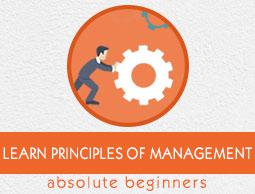Management Principles - Quick Guide
Management Principles - Overview
In today’s volatile economies, every organization needs strong managers to lead its people towards achieving the business objectives. A manager’s primary challenge is to solve problems creatively and plan effectively. Managers thus fulfill many roles and have different responsibilities within the various levels of an organization.
Management began to materialize as a practice during the Industrial Revolution, as large corporations began to emerge in the late 19th century and developed and expanded into the early 20th century. Management is regarded as the most important of all human activities. It may be called the practice of consciously and continually shaping organizations.
What is Management?
Management is a universal phenomenon. Every individual or entity requires setting objectives, making plans, handling people, coordinating and controlling activities, achieving goals and evaluating performance directed towards organizational goals. These activities relate to the utilization of variables or resources from the environment − human, monetary, physical, and informational.

Human resources refer to managerial talent, labor (managerial talent, labor, and services provided by them), monetary resources (the monetary investment the organization uses to finance its current and long-term operations), physical resources (raw materials,physical and production facilities and equipment) and information resources (data and other kinds of information).
Management is essentially the bringing together these resources within an organization towards reaching objectives of an organization.
Management Defined
Management has been defined by various authors/authorities in various ways. Following are few often-quoted definitions −
Management guru, Peter Drucker, says the basic task of management includes both marketing and innovation. According to him, Management is a multipurpose organ that manages a business and manages managers, and manages workers and work.
Harold Koontz defined management as the art of getting things done through and with people in formally organized groups.
All these definitions place an emphasis on the attainment of organizational goals/objectives through deployment of the management process (planning, organizing, directing, etc.) for the best use of organization’s resources. Management makes human effort more fruitful thus effecting enhancements and development.
Management is the process of planning, organizing, leading, and controlling an organization’s human, financial, physical, and information resources to achieve organizational goals in an efficient and effective manner.
The principles of management are the means by which a manager actually manages, that is, get things done through others − individually, in groups, or in organizations.
Formally defined, the principles of management are the activities that plan, organize, and control the operations of the basic elements of [people], materials, machines, methods, money and markets, providing direction and coordination, and giving leadership to human efforts, so as to achieve the sought objectives of the enterprise.
Is Management an Art or a Science?
Like any other discipline such as law, medicine or engineering, managing is an art – at least that is what most people assume. Management concepts need to be artistically approached and practiced for its success. It is understood that managing is doing things artistically in the light of the realities of a situation.
If we take a closer look at it, Management, when practiced, is definitely an art but its underlying applications, methods and principles are a science. It is also opined that management is an art struggling to become a science.
Management as an Art
The personal ingenious and imaginative power of the manager lends management the approach of an art. This creative power of the manager enriches his performance skill. In fact, the art of managing involves the conception of a vision of an orderly whole, created from chaotic parts and the communication and achievement of this vision. Managing can be called art of arts
because it organizes and uses human talent, which is the basis of every artistic activity.
Management as a Science
Management is a body of systematized knowledge accumulated and established with reference to the practice and understanding of general truth concerning management. It is true that the science underlying managing is not as accurate or comprehensive as physical sciences (such as chemistry or biology) which deal with non-human entities.
The involvement of the human angle makes management not only complex but also controversial as pure science. Nevertheless, the study of the scientific elements in management methodologies can certainly improve the practice of management.
Management as a Science and Art
Science urges us to observe and experiment a phenomenon, while art teaches us the application of human skill and imagination to the same. In order to be successful, every manager needs do things effectively and efficiently. This requires a unique combination of both science and art. We can say that the art of managing begins where the science of managing stops. As the science of managing is imperfect, the manager must turn to artistic managerial ability to perform a job satisfactorily.
Management Principles - Role of Managers
Every organization has ‘Managers’ who are entrusted with the responsibility of guiding and directing the organization to achieve its goals.

Managers administer and coordinate resources effectively and efficiently to channelize their energy towards successful accomplishment of the goals of the organization. Managers are required in all the activities of organizations. Their expertise is vital across departments throughout the organization.
Role of Managers
Managers are the primary force in an organization's growth and expansion. Larger organizations are particularly complex due to their size, process, people and nature of business. However, organizations need to be a cohesive whole encompassing every employee and their talent, directing them towards achieving the set business goals. This is an extremely challenging endeavor, and requires highly effective managers having evolved people management and communication skills.
The Top Management
The top level executives direct the organization to achieve its objectives and are instrumental in creating the vision and mission of the organization. They are the strategic think-tank of the organization.
Senior Management
The General Manager is responsible for all aspects of a company. He is accountable for managing the P&L (Profit & Loss) statement of the company. General managers usually report to the company board or top executives and take directions from them to direct the business.
The Functional Manager is responsible for a single organizational unit or department within a company or organization. He in turn is assisted by a Supervisor or groups of managers within his unit/department. He is responsible for the department’s profitability and success.
Line and Staff Managers
Line Managers are directly responsible for managing a single employee or a group of employees. They are also directly accountable for the service or product line of the company. For example, a line manager at Toyota is responsible for the manufacturing, stocking, marketing, and profitability of the Corolla product line.
Staff Managers often oversee other employees or subordinates in an organization and generally head revenue consuming or support departments to provide the line managers with information and advice.
Project Managers
Every organization has multiple projects running simultaneously through its life cycle. A project manager is primarily accountable for leading a project from its inception to completion. He plans and organizes the resources required to complete the project. He will also define the project goals and objectives and decide how and at what intervals the project deliverables will be completed.
The Changing Roles of Management and Managers
Every organization has three primary interpersonal roles that are concerned with interpersonal relationships. The manager in the figurehead role represents the organization in all matters of formality. The top-level manager represents the company legally and socially to the outside world that the organization interacts with.
In the supervisory role, the manager represents his team to the higher management. He acts as a liaison between the higher management and his team. He also maintains contact with his peers outside the organization.
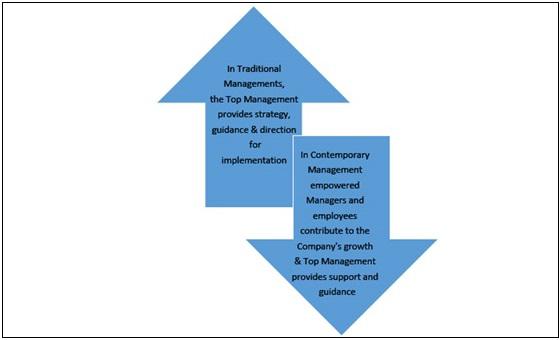
Mintzberg's Set of Ten Roles
Professor Henry Mintzberg, a great management researcher, after studying managers for several weeks concluded that, to meet the many demands of performing their functions, managers assume multiple roles.
He propounded that the role is an organized set of behaviors. He identified the following ten roles common to the work of all managers. These roles have been split into three groups as illustrated in the following figure.
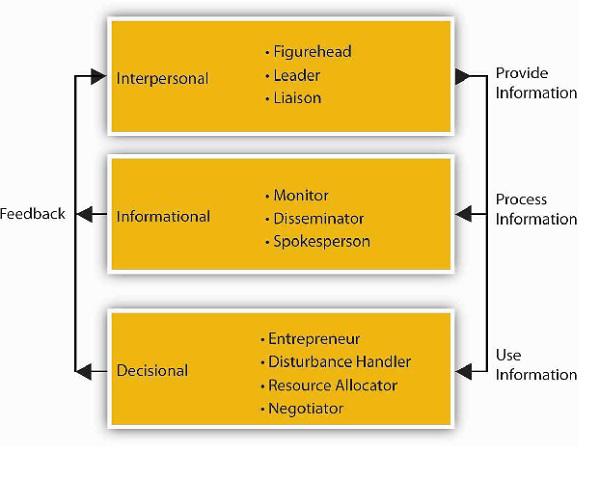
Interpersonal Role
Figurehead − Has social, ceremonial and legal responsibilities.
Leader − Provides leadership and direction.
Liaison − Networks and communicates with internal and external contacts.
Informational Role
Monitor − Seeks out information related to your organization and industry, and monitors internal teams in terms of both their productivity and well-being.
Disseminator − Communicates potentially useful information internally.
Spokesperson − Represents and speaks for the organization and transmits information about the organization and its goals to the people outside it.
Decisional Role
Entrepreneur − Creates and controls change within the organization - solving problems, generating new ideas, and implementing them.
Disturbance Handler − Resolves and manages unexpected roadblocks.
Resource Allocator − Allocates funds, assigning staff and other organizational resources.
Negotiator − Involved in direct important negotiations within the team, department, or organization.
Managerial Skills
Henri Fayol, a famous management theorist also called as the Father of Modern Management, identified three basic managerial skills - technical skill, human skill and conceptual skill.
Technical Skill
Knowledge and skills used to perform specific tasks. Accountants, engineers, surgeons all have their specialized technical skills necessary for their respective professions. Managers, especially at the lower and middle levels, need technical skills for effective task performance.
Technical skills are important especially for first line managers, who spend much of their time training subordinates and supervising their work-related problems.
Human Skill
Ability to work with, understand, and motivate other people as individuals or in groups. According to Management theorist Mintzberg, the top (and middle) managers spend their time: 59 percent in meetings, 6 percent on the phone, and 3 percent on tours.
Ability to work with others and get co-operation from people in the work group. For example, knowing what to do and being able to communicate ideas and beliefs to others and understanding what thoughts others are trying to convey to the manager.
Conceptual Skill
Ability to visualize the enterprise as a whole, to envision all the functions involved in a given situation or circumstance, to understand how its parts depend on one another, and anticipate how a change in any of its parts will affect the whole.
Creativity, broad knowledge and ability to conceive abstract ideas. For example, the managing director of a telecom company visualizes the importance of better service for its clients which ultimately helps attract a vast number of clients and an unexpected increase in its subscriber base and profits.
Other Managerial Skills
Besides the skills discussed above, there are two other skills that a manager should possess, namely diagnostic skill and analytical skill.
Diagnostic Skill − Diagnose a problem in the organization by studying its symptoms. For example, a particular division may be suffering from high turnover. With the help of diagnostic skill, the manager may find out that the division’s supervisor has poor human skill in dealing with employees. This problem might then be solved by transferring or training the supervisor.
Analytical Skill − Ability to identify the vital or basic elements in a given situation, evaluate their interdependence, and decide which ones should receive the most attention. This skill enables the manager to determine possible strategies and to select the most appropriate one for the situation.
For example, when adding a new product to the existing product line, a manager may analyze the advantages and risks in doing so and make a recommendation to the board of directors, who make the final decision.
Diagnostic skill enables managers to understand a situation, whereas analytical skill helps determine what to do in a given situation.
The P-O-L-C Framework
The primary challenge faced by organizations and managers today is to creatively solve business problems. The principles of management are guidelines using which managers can tackle business challenges.
The principles of management have been categorized into the four major functions of planning, organizing, leading, and controlling popularly known as the P-O-L-C framework.
The P-O-L-C Framework
| Planning |
- Defining Organization Vision & Mission
- Setting Goals & Objectives
- Strategizing
- Plan of Action to Achieve Goals
|
| Organizing |
- Formulate Organizational Structure
- Resource Allocation
- Job Design
|
| Leading |
- Leadership & Direction
- Motivation
- Coordination & Communication
|
| Controlling |
- Process & Standards
- Review & Evaluation
- Corrective Action
|
Planning
Planning is the first and the most important function of management that involves setting objectives and determining a course of action for achieving those objectives. Planners are essentially the managers who are best aware of environmental conditions facing their organization and are able to effectively analyze and predict future conditions. It also requires that managers should be good decision makers.
Planning involves selecting missions and objectives and the actions to achieve them, it requires decision making, i.e. choosing future courses of action from among alternatives.
Planning means determining what the organization’s position and situation should be at some time in the future and deciding how best to bring about that situation. It helps maintain managerial effectiveness by guiding future activities.
Planning as a process typically involves the following steps −
- Selection of goals for the organization.
- Establishment of goals for each of the organization’s sub-units.
- Establishment of programs for achieving goals in a systematic manner.
Types of Planning
Strategic planning involves analyzing competitive opportunities and threats, as well as the strengths and weaknesses of the organization. It also involves determining how to position the organization to compete effectively in their environment.
Tactical planning is creating the blueprint for the lager strategic plan. These plans are often short term and are carried out by middle-level managers.
Operational planning generally covers the entire organization’s goals and objectives and put into practice the ways and action steps to achieve the strategic plans. They are very short terms usually less than a year.
Organizing
Once a manager has created a work plan, the next phase in management cycle is to organize the people and other resources necessary to carry out the plan. Organizing should also consider the resources and physical facilities available, in order to maximize returns with minimum expenditure.
Organizing may be referred to as the process of arranging and distributing the planned work, authority and resources among an organization’s members, so they can achieve the organization’s goals.
Organizing involves the following steps −
Creating the organizational structure − The framework of the organization is created within which effort is coordinated allocating human resources to ensure the accomplishment of objectives. This structure is usually represented by an organizational chart, which is a graphic representation of the chain of command within an organization.
Making organizational design decisions − Decisions are made about the structure of an organization.
Making job design decisions − Roles and responsibilities of individual jobs, and the process of carrying out the duties is defined.
Organizing at the level of a particular job involves how best to design individual jobs so as to most effectively utilize human resources. Traditionally, job design was based on principles of division of labor and specialization, which assumed that the more narrow the job content, the more proficient the individual performing the job could become.
Leading
Organizations as they grow, develop complex structures with an increasing need for co-ordination and control. To cope and manage such situations, leadership is necessary to influence people to cooperate towards a common goal and create a situation for collective response.
Leading entails directing, influencing, and motivating employees to perform essential tasks. It also involves the social and informal sources of influence to inspire others. Effective managers lead subordinates through motivation to progressively attain organizational objectives.
Personality research and study of job attitudes in Behavioral Science provides important insight on the need for coordination and control. Thus it becomes important for leadership to create harmony among individual efforts to collectively work towards organizational goals.
Controlling
Managers at all levels engage in the managerial function of controlling to some degree. Two traditional control techniques are budget and performance audits. An audit involves a physical examination and verification of the organization’s records and supporting documents. A budget audit provides information about where the organization is with respect to procedures followed for financial planning and control, whereas a performance audit might try to determine whether the figures reported are a reflection of actual performance.
Controlling involves measuring performance against goals and plans, and helping correct deviations from standards. As a matter of fact, controlling facilitates the accomplishment of plans by ensuring that performance does not deviate from standards.
Controlling is not just limited to organization’s financial state, but also spans across areas like operations, compliance with company policies and other regulatory policies, including many other activities within the organization.
The management functions thus most effectively cover the broad scope of a manager’s duties and responsibilities. Though the nature and complexities faced by businesses have undergone a vast change over the years, the functions of management remain the same.
Classical Schools Of Thought
Management as a practice gained ground when the concept of working together in groups to achieve common objectives was realized by men. But the study of management as a systematic field of knowledge began at the advent of the Industrial Revolution, which ushered in a new era of serious thinking and theorizing on management.
To begin with, there is no single universally accepted theory of management. The wild array of management theories could even look like a jungle
says Harold Koontz. However, to help put the different theories in perspective, we shall discuss them as representing different schools of thought.
Classical School of Management Thought
Scientific Management and F. W. Taylor
Scientific management, according to an early definition, refers to that kind of management which conducts a business or affairs by standards established by facts or truths gained through systematic observation, experiment, or reasoning.
Advocators of this school of thought attempted to raise labor efficiency primarily by managing the work of employees on the shop floor.
Frederick Winslow Taylor, who is generally acknowledged as the father of scientific management
believed that organizations should study tasks and prepare precise procedures. His varied experience gave him ample opportunity to have firsthand knowledge and intimate insight into the problems and attitude of workers, and to explore great possibilities for improving the quality of management in the workplace.
Formulating his theory based on firsthand experience, Taylor’s theory focused on ways to increase the efficiency of employees by molding their thought and scientific management.
Henry Gnatt, an associate of Taylor, developed the Gnatt Chart, a bar graph that measures planned and completed work along with each stage of production. This visual display chart has been a widely used control and planning tool since its development in 1910. Following is a sample of Gnatt Chart.
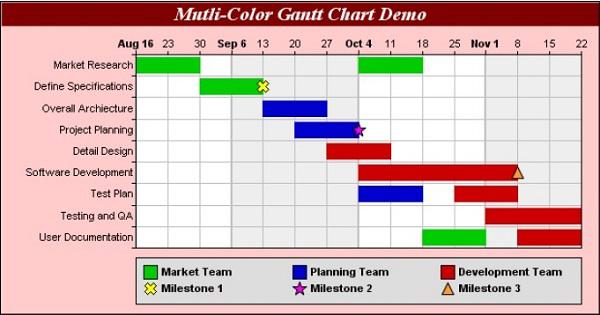
Frank Gilbreth and his wife, Lillian Moller Gilbreth further improvised on Taylor’s time studies, devising motion studies
by photographing the individual movements of each worker. They carefully analyzed the motions and eliminated unnecessary ones. These motion studies were preceded by timing each task, so the studies were called time and motion studies.
Applying time and motion studies to bricklaying, the Gilbreths devised a way for workers to lay bricks that eliminated wasted motion and raised their productivity from 1,000 bricks per day to 2,700 bricks per day.
The Basic Principles of Scientific Management
Developing new standard method of doing each job.
Selecting training and developing workers instead of allowing them to self-train and choose their own tasks.
Develop cooperation between workers and management.
Division of work on the basis of the group that is best fitted to do the job.
Henry Fayol’s Universal Process theory
One of the oldest and most popular approaches, Henry Fayol’s theory holds that administration of all organizations – whether public or private, large or small – requires the same rational process or functions.
This school of thought is based on two assumptions −
Although the objective of an organization may differ (for example, business, government, education, or religion), yet there is a core management process that remains the same for all institutions.
Successful managers, therefore, are interchangeable among organizations of differing purposes. The universal management process can be reduced to a set of separate functions and related principles.
Fayol identifies fourteen universal principles of management, which are aimed at showing managers how to carry out their functional duties.
| S.No |
Universal principles of management |
Managers Functional Duties |
| 1 |
Specialization of labor |
This improves the efficiency of labor through specialization, reducing labor time and increasing skill development. |
| 2 |
Authority |
This is the right to give orders which always carry responsibility commensurate with its privileges. |
| 3 |
Discipline |
It relies on respect for the rules, policies, and agreements that govern an organization. Fayol ordains that discipline requires good superiors at all levels. |
| 4 |
Unity of command |
This means that subordinates should receive orders from one superior only, thus avoiding confusion and conflict. |
| 5 |
Unity of direction |
This means that there should be unity in the directions given by a boss to his subordinates. There should not be any conflict in the directions given by a boss. |
| 6 |
Subordination of individual interest to common good |
According to this principle, the needs of individuals and groups within an organization should not take precedence over the needs of the organization as a whole. |
| 7 |
Remuneration |
Wages should be equitable and satisfactory to employees and superiors. |
| 8 |
Centralization |
Levels at which decisions are to be made should depend on the specific situation, no level of centralization or decentralization is ideal for all situations. |
| 9 |
Scale of chain |
The relationship among all levels in the organizational hierarchy and exact lines of authority should be unmistakably clear and usually followed at all times, excepting special circumstances when some departure might be necessary. |
| 10 |
Order |
There should be a place for everything, and everything should be in its place. This is essentially a principle of organization in the arrangement of things and people. |
| 11 |
Equity |
Employees should be treated equitably in order to elicit loyalty and devotion from personnel. |
| 12 |
Personal tenure |
Views unnecessary turnover to be both the cause and the effect of bad management; Fayol points out its danger and costs. |
| 13 |
Initiative |
Subordinates should be encouraged to conceive and carryout ideas. |
| 14 |
Esprit de corps |
Team work, a sense of unity and togetherness, should be fostered and maintained. |
Behavioral and Human Relations Approach
The criticism of scientific and administrative management approach as advocated by Taylor and Fayol, respectively gave birth to the behavioral approach to management. One of the main criticisms leveled against them are their indifference to and neglect of the human side of the enterprise in management dealings.
A good number of sociologists and psychologists like Abraham Maslow, Hugo Munsterberg, Rensis Likert, Douglas McGregor, Frederick Herzberg, Mary Parker Follet, and Chester Barnard are the major contributors to this school of thought, which is further subdivided by some writers into the Human Relations approach and the Human Behavioral approach.
Elton Mayo and Hawthorne Studies
Elton Mayo and Hugo Munsterberg are considered pioneers of this school. The most important contribution to this school of thought was made by Elton Mayo and his associates through Hawthorne plant of the Western Electric Company between 1927 and 1932.
Following are the findings of Mayo and his colleagues from Hawthorne studies −
Human/social element operated in the workplace and productivity increases were as much an outgrowth of group dynamics as of managerial demands and physical factors.
Social factors might be as powerful a determinant of worker-productivity as were financial motives.
Management with an understanding of human behavior, particularly group behavior serves an enterprise through interpersonal skills such as motivating, counseling, leading and communicating − known as Hawthorne effect.
Employees or workers are social beings, so it is very important to fit them into a social system, resulting in a complete socio-technical system in an organization.
Criticism
Following are the criticisms of Hawthorne studies −
Unreasonably high emphasis on the social or human side as against organizational needs.
The approach facilitates exploitation of employees by keeping them satisfied and happy, manipulating their emotions which in fact, serves the management goal of increasing productivity.
Modern Schools Of Thought
This school of thought primarily focuses on the development of each factor of both workers and the organization. It analyzes the interrelationship of workers and management in all aspects.
System Approach and Contingency Approach are the two approaches by this school of thought.
Chester Barnard and Social Systems Theory
One of the most important contributions to this school has been made by Chester I. Barnard. His classic treatise entitled The Functions of the Executive
, published in 1938, is considered by some management scholars as one of the most influential books published in the entire field of management. Like Fayol, Barnard based his theories and approach to management on the basis of his first-hand experience as a top-level executive.
Fundamentals of System Approach −
All organizations are a co-operative system.
As co-operative systems, organizations are a combination of complex physical, biological, personal and social components, which are in a specific systematic relationship by reason of the co-operation of two or more persons for at least one definite end.
An employee’s role and his co-operation are a strategic factor in achieving organizational objectives.
Criticism
Following are the criticisms that this theory received.
Long on intellectual appeal and catchy terminology and short on verifiable facts and practical advice.
Complex in nature, particularly when it comes to the study of large and complex organizations.
However, we can conclude that the system approach is an instructive approach and way of thinking rather than a systematic model of solution to explain the complexities of managing modern organizations.
Contingency Approach and Recent Contributions
The Contingency Management theory evolved out of the System Approach to managing organizations. According to the Contingency approach, management is situational; hence there exists no single best approach to management, as situations that a manager faces is always changing.
However, situations are often similar to the extent that some principles of management can be effectively applied by identifying the relevant contingency variables in the situation and then evaluating them.
Peter F. Drucker, W. Edwards Deming, Laurence Peter, William Ouchi, Thomas Peters, Robert Waterman, and Nancy Austin are some of the most important contributors to management thought in recent times. This has emerged perhaps as the best approach as it encourages management to search for the correct situational factors for applying appropriate management principles effectively.
On the basis of the Tom Peters and Robert Waterman’s research focusing on 43 of America’s most successful companies in six major industries, the following 9 principles of management are embodied in excellent organizations −
Managing Ambiguity and Paradox − The ability of managers to hold two opposing ideas in mind and at the same time able to function effectively.
A Bias for Action − A culture of impatience with lethargy and inertia that otherwise leaves organizations unresponsive.
Close to the Customer − Staying close to the customer to understand and anticipate customer needs and wants.
Autonomy and Entrepreneurship − Actions that foster innovation and nurture customer and product champions.
Productivity through People − Treating rank-and-file employees as a source of quality.
Hands-On, Value-Driven − Management philosophy that guides everyday practice and shows the management’s commitment.
Stick to the Knitting − Stay with what you do well and the businesses you know best.
Simple Form, Lean Staff − The best companies have very minimal, lean headquarters staff.
Simultaneous Loose-Tight Properties − Autonomy in shop-floor activities and centralized values.
Quality School of Management
The Quality School of Management (also known as Total Quality Management, TQM) is a fairly recent and comprehensive model for leading and operating an organization. The prime focus is on continually improving performance by focusing on customers while addressing the needs of all stakeholders. In other words, this concept focuses on managing the entire organization to deliver high quality to customers.
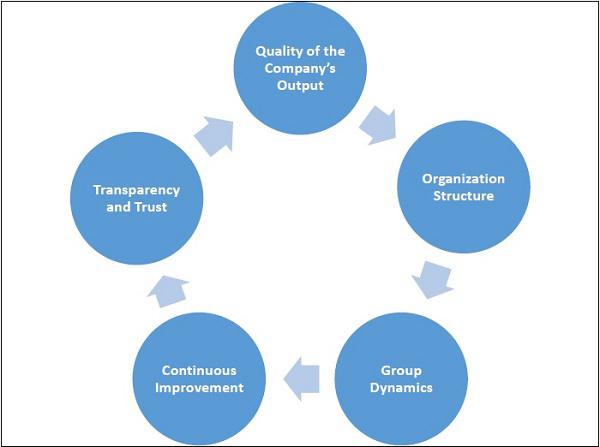
The quality school of management considers the following in its theory −
Quality of the Company’s Output − Focus on providing goods and services that satisfy the customer requirements, which is presumed to be a key to organizational survival and growth.
Organizational Structure − Every organization is made up of complex systems of customers and suppliers and every individual will need to function as both a supplier and a customer.
Group Dynamics − Organization should foster an environment of working in groups. Management should recognize and nurture harmony and efficiency in these groups, which are the catalysts for planning and problem solving.
Continuous Improvement − Constantly review the company’s policies and processes. This will lead to specialization and ultimately better outcomes
Transparency and Trust − Connect with employees at all levels and create a culture of trust and stability.
Kaizen Approach
Kaizen means that everyone is involved in making improvements. Kaizen (pronounced ky-zen) is based on the Japanese management concept for incremental change and improvement.
The idea of continuous improvement suggests that managers, teams, and individuals learn from both their accomplishments and their mistakes. It is a long-term approach to work that systematically seeks to achieve small, incremental changes in processes in order to improve efficiency and quality.
While the majority of changes may be small, the greatest impact may be improvements or changes that are led by senior management as transformational projects, or by cross-functional teams as Kaizen events.
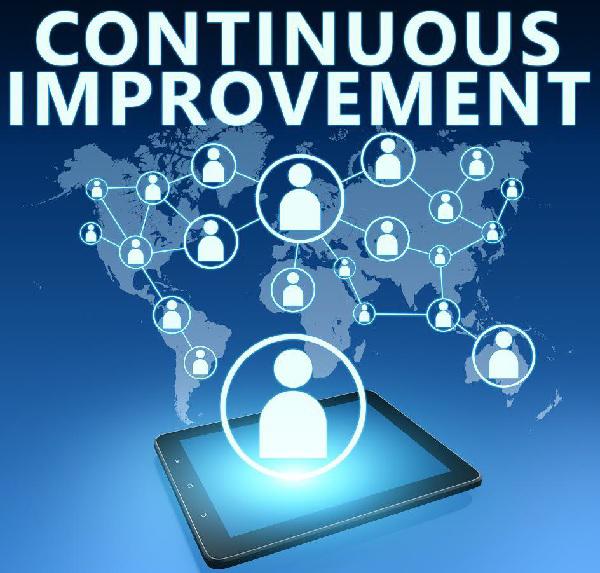
Kaizen Process
Following are the steps involved in Kaizen Process.
- Identifying opportunities for improvement
- Testing new approaches
- Recording the results
- Recommending changes
Reengineering Approach
Reengineering Approach sometimes called Business Process Reengineering (BPR), involves a complete rethinking and transformation of key business processes, leading to strong horizontal coordination and greater flexibility in responding to changes in the environment. The reengineering approach focuses on sensing the need to change, anticipating changes, and reacting effectively when it happens.
Reengineering Process
Following are the steps involved in reengineering process.
- Develop business vision and process objectives
- Identify business processes
- Scope and measure existing processes
- Design and build new process prototypes
- Implement and manage changes
Future of Management
Modern management approaches respect the classical, human resource, and quantitative approaches to management. However, successful managers recognize that although each theoretical school has limitations in its applications, each approach also offers valuable insights that can broaden a manager's options in solving problems and achieving organizational goals. Successful managers work to extend these approaches to meet the demands of a dynamic environment.
Just as organizations evolve and grow, employee needs also change over time; people possess a range of talents and capabilities that can be developed. In order to optimize outcomes, organizations and managers, should respond to individuals with a wide variety of managerial strategies and job opportunities.
Important aspects to be considered, as the 21st century progresses, include the following −
Organizations need to commit to not just meeting customer needs but exceeding customer expectations through quality management and continuous improvement of operations.
Reinvent new methods of process improvements and constantly learn new ways and best practices from practices in other organizations and environments.
Organizations must reinvest in their most important asset, their human capital. They need commit to effectively and positively use human resources by reducing attrition rates.
Managers must excel in their leadership responsibilities to perform numerous different roles.
Management Principles - Environment
In this chapter, we will discuss the environment of management and the factors that affect the environment.
The terms organization, administration and management are often used interchangeably. Sometimes they are used to mean one and the same thing.
Organization is −
The collection, preservation and co-ordination of the elements of an enterprise in an integrated manner.
It brings together various resources of an enterprise into a single harmonious whole.
It warrants the utilization of resources for the accomplishment of its objectives.
Administration is −
The efficient organization or utilization of the resources of an organization to achieve the goals.
It determines the principles for ensuring the effective performance of the activities of different divisions and branches of the enterprise.
Administration is above management, and exercises control over the finance and licensing of an organization.
Management is −
An executive function that makes the decisions within the confines of the framework, which is set up by the administration.
Management consists of a group of managerial persons, who leverage their specialist skills to fulfill the objectives of an organization.
The success of an enterprise/institution is dependent on how efficiently the management can execute plans and policies set by the administration.
The Management & Administration Inter-Relationship
Management is the act or function of putting into practice the policies and plans decided upon by the administration. Administration cannot be successful without the co-operation of management. The job of each manager is, therefore, to win the co-operation of all those who work under him so that they work for enterprise goals set by administration.
Administrators are mainly found in the government, military, religious and educational organizations. Management, on the other hand, is used by business enterprises. The role of a manager is to monitor and shape the environment, to anticipate changes, and react quickly to them.
Management Principles- Factors Affecting
There are numerous factors that affect an organization or the management. Managers can monitor these factors/environments through boundary spanning — a process of gathering information about developments that could impact the future of the organization.
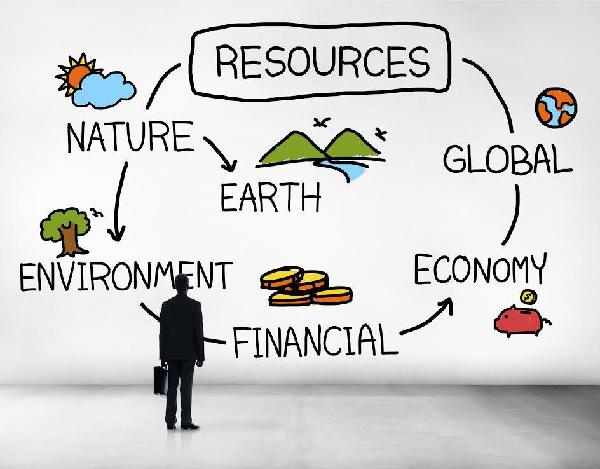
Following types of factor/environment affect management −
- Microeconomic factors
- Macroeconomic factors
To lead an organization efficiently, every organization must know where it is situated, what are its external and internal influences.
| Microeconomic Factors |
Macroeconomic Factors |
|
Company-specific influences that have a direct impact on its business operations and success.
Components within the control of an organization can be managed and altered.
|
Broad economic forces and global events are out of control of any business or company.
Forces indirectly affect company objectives.
Volatile and risky, and a savvy manager must be agile to sidestep a cascading macroeconomic crisis to keep the company intact.
|
|
For example, a company’s revenue, earnings and margin.
The employees, Stakeholders, the production volume of the products and the advertising campaigns can also be called microfactors.
|
For example, the country’s economic output, inflation, its political environment, unemployment, etc.
|
Macro (Outer Environment)
Factors that indirectly impact the organization, its operation and working condition is known as the outer environment or macro environment. These external factors cannot be controlled by the organization.

Following are some of the macro environment factors −
| Political-legal environment |
The country’s unique political and legal landscape within which organizations function.
The effects of this are quite visible. For e.g.: the effect of changing taxes or raising interest rates.
|
| Technology |
Companies have to carefully evaluate the technological developments that it wishes to embrace as it is a cost intensive factor and provide millions in return to one company and take millions from another. |
| Socio-cultural environment |
The means of communication, the country’s infrastructure, its education system, the purchasing power of the citizens, family values, work ethics and preferences, etc. |
Micro (Inner Environment)
These are the factors within an organization that can be controlled and affect the immediate area of an organization’s operations.
Though not all factors can be effectively controlled, but relative to the macro environment factors, a visible control can be exercised in this case.
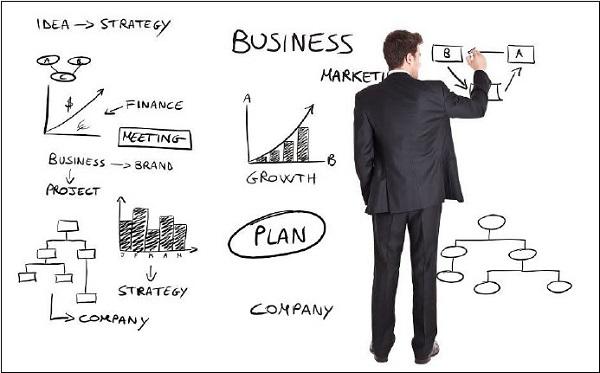
Following are some of the micro environment factors −
| Employees |
Employees exert great influence on the oorganization. It is imperative to find the right people for each job.
Organizations need to motivate employees positively and retain specialized talent.
|
| Owners and the Management |
Investors are major influencers on a company’s revenue and operations.
It is important that the owners are satisfied with the company. It is the manager's job to balance the aims of the company and the owners.
|
| Consumers |
Competition and consumerism has rendered multiple alternatives for the same product in different brands. Organizations recognize that it is in their own interest to keep consumers happy.
|
| Suppliers |
The suppliers or contractors manage the inputs of organizations and provide products or services that a company needs directly or need it to add value to the company’s own products or services.
It is important to keep suppliers happy to ensure a smooth input supply system.
|
| Competition |
Competitors affect profits by trying to divert business. A capable manager will need to constantly study and analyze its competition if the company wants to maintain its position in the market.
|
Management Principles - Organization
A management environment within an organization is composed of the elements like its current employees, management, and especially corporate culture, which defines employee behavior. Although some elements affect the organization as a whole, others singularly affect the manager.
A manager's philosophical or leadership style directly impacts the employees. Traditional managers give explicit instructions to employees, while progressive managers empower employees to make most of their own decisions. Changes in philosophy and/or leadership style are under the control of the manager. Let us look at some of the important components of a management environment.
Mission and Vision
Mission and vision are both foundations of an organization’s purpose. These are the objectives of the organization that are communicated in written. Mission and vision are statements from the organization that bring out what an organization is set for, what is its purpose, its value and its future. A popular study by a consulting firm reports that 90% of the Fortune 500 firms surveyed issue some form of mission and vision.
A Mission Statement defines the company's goals, ethics, culture, and norms for decision-making. They are often longer than vision statements. Sometimes mission statements also include a summation of the firm’s values. Values are the beliefs of an individual or group, and in this case the organization, in which they are emotionally invested.
Company Policies
Company policies are formal guidelines and procedures that direct how certain organizational situations are addressed. Companies establish policies to provide guidance to employees so that they act in accordance to certain circumstances that occur frequently within their organization. Company policies are an indication of an organization's personality and should coincide with its mission statement.
Organizational Culture
Organizational culture is an organization's believes and values that represent its personality. Just as each person has a distinct personality, so does each organization. The culture of an organization distinguishes it from others and shapes the actions of its members.
Values
Values are the basic beliefs that define employees' successes in an organization. A hero is an exemplary person who reflects the image, attitudes, or values of the organization and serves as a role model to other employees. A hero is sometimes the founder of the organization (think Bill Gates of Microsoft).
Rites and Rituals
Rites and rituals are routines or ceremonies that the company uses to recognize high‐performing employees. Awards banquets, company gatherings, and quarterly meetings can acknowledge distinguished employees for outstanding service. The honorees are meant to exemplify and inspire all employees of the company during the rest of the year.
Resources
Resources are the people, information, facilities, infrastructure, machinery, equipment, supplies, and finances at the organization's disposal. People are the most important resource of an organization. Information, facilities, machinery equipment, materials, supplies, and finances are supporting, nonhuman resources that complement workers in their quest to accomplish the organization's mission statement. The availability of resources and the way that managers value the human and nonhuman resources impact the organization's environment.
Management Principles - Leadership Styles
Management philosophy is the manager's set of personal beliefs and values about people and work. It is something that the manager can control. Eminent social psychologist and management researcher, Douglas McGregor, emphasized that a manager's philosophy creates a self-fulfilling prophecy. Theory X managers treat employees almost as children who need constant direction, while Theory Y managers treat employees as competent adults capable of participating in work-related decisions.
These managerial philosophies then have a subsequent effect on employee behavior, leading to the self‐fulfilling prophecy. As a result, organizational and managerial philosophies need to be in harmony.
The Many Aspects of Leadership
The character of top executives and their philosophy have an important influence on the extent to which authority is decentralized.
Sometimes top managers are dictatorial, tolerating no interference with authority and information they hoard. Conversely, some managers find decentralization a means to make large business work successfully.
The number of coworkers involved within a problem‐solving or decision‐making process reflects the manager's leadership style.
Empowerment means sharing information, rewards and power with employees so that they are equal contributors to the organizations outcomes.
An empowered and well-guided workforce may lead to heightened productivity and quality, reduced costs, more innovation, improved customer service, and greater commitment from the employees of the organization.
Each business must go through the process of identifying its individual management philosophy and continuously review and evaluate the same to see if it is aligned with its larger purpose.

Leadership Styles
Leadership can be stated as the ability to influence others. We may also define leadership as the process of directing and influencing people so that they will strive willingly and enthusiastically towards the achievement of group objectives.
Ideally, people should be encouraged to develop not only willingness to work but also willingness to work with confidence and zeal. A leader acts to help a group achieve objectives through the exploitation of its maximum capabilities.
In the course of his survey of leadership theories and research, Management theorist, Ralph Stogdill, came across innumerable definitions of leadership.
Qualities/Ingredients of Leadership
Every group of people that perform satisfactorily has somebody among them who is more skilled than any of them in the art of leadership. Skill is a compound of at least four major ingredients −
The ability to use power effectively and in a responsible manner.
The ability to comprehend that human beings have different motivation forces at different times and in different situations.
The ability to inspire.
The ability to act in a manner that will develop a climate conducive to responding and arousing motivation.
Leadership styles/types can be classified under the following categories −
Leadership Style Based on the Use of Authority
The traditional way of classifying leadership is based on the use of authority by the leader. These are classified as −
| Autocratic leadership |
Democratic leadership |
Free-rein leadership |
| Use of coercive power to give order and expect compliance. Dogmatic and leads by the ability to withhold or give punishment or rewards, commands and expects compliance. |
Participative leader who usually consults with subordinates on proposed actions and decisions, and encourages participation from them. |
As opposed to autocratic leadership, this leadership style provides maximum freedom to subordinates. |
Some autocratic leaders happen to be benevolent autocrats , willing to hear and consider subordinates’ ideas and suggestions but when a decision is to be made, they turn to be more autocratic than benevolent. |
Ranges from the person who does not take action without subordinates’ concurrence to the one who makes decisions but consults with sub-ordinates before doing so. |
Favors autonomy and exercises minimal control. Gives workers a high degree of independence in their operations. |
Leadership Continuum
Propounded by Robert Tannenbaum and Warren H. Schmidt, according to the Leadership Continuum, leadership style depends on three forces: the manager, employees and the situation.
Thus, instead of suggesting a choice between the two styles of leadership, democratic or autocratic, this approach offers a range of styles depicting the adaptation of different leadership styles to different contingencies (situations), ranging from one that is highly subordinate-centered to one that is highly boss-centered.
Features of Leadership Continuum
The characteristics of individual subordinates must be considered before managers adopt a leadership style.
A manager can be employee-centered and allow greater freedom when employees identify with the organization’s goals, are knowledgeable and experienced, and want to have decision making responsibility.
Where these conditions are absent, managers might need to initially adopt a more authoritarian style. As employees mature in self-confidence, performance and commitment, managers can modify their leadership style.
Leadership Styles in Managerial Grid
Developed by Robert Blake and Jane Mouton, this approach as shown in the following grid, has two dimensions −
Concern for people which includes such elements as provision of good working conditions, placement of responsibility on the basis of trust rather than concern for production.
Concern for production includes the attitudes of a supervisor toward a wide variety of things, such as quality of staff services, work efficiency, volume and quality of output, etc.
The bi-dimensional managerial grid identifies a range of management behavior based on the various ways that task-oriented and employee-oriented styles (each expressed as a continuum on a scale of 1 to 9) can interact with each other.
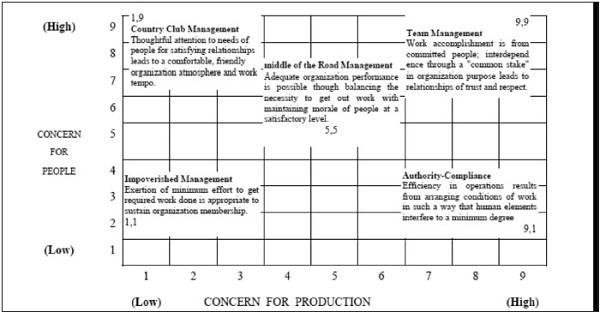
Management Style 1,1 −
Impoverished management with low concern for both people and production.
This is called laissez-faire management because the leader does not take a leadership role.
Also known as delegative leadership is a type of leadership style in which leaders are hands-off and allow group members to make the decisions.
Management Style 1,9 −
Country club management having high concern for employees but low concern for production.
These leaders predominantly use reward power to maintain discipline and to encourage the team to accomplish its goals.
Management Style 5,5 −
Management Style 9,1 −
Authoritarian management with high concern for production but low concern for employees exercising disciplinary pressure.
This approach may result in high production but low people satisfaction levels.
Management Style 9,9 −
Democratic management with high concern for both production, and employee morale and satisfaction.
The leader's high interest in the needs and feelings of employees affects productivity positively.
This theory concluded that style 9,9 is the most effective management style as this leadership approach will, in almost all situations, result in improved performance, low turnover and absenteeism, and high employee satisfaction.
Systems of Management
Professor Rensis Likert of Michigan University studied the patterns and styles of managers and leaders for three decades. He suggests four styles of management, which are the following −
Exploitative-authoritative management −
Managers are highly autocratic, showing little trust in subordinates.
The prime drivers are motivating people through fear and punishment.
Managers engage in downward communication and limit decision making to the top.
Benevolent-authoritative management −
The manager has condescending confidence and trust in subordinates (master-servant relationship).
Management uses rewards and upward communication is censored or restricted.
The subordinates do not feel free to discuss things about the job with their superior. Teamwork or communication is minimal and motivation is based on a system of rewards.
Consultative management −
Managers have substantial but not complete confidence and trust in subordinates.
Use rewards for motivation with occasional punishment and some participation, usually try to make use of subordinates' ideas and opinions.
Communication flow is both up and down.
Broad policy and general decisions are made at the top while allowing specific decisions to be made at lower levels and act consultatively in other ways.
Participative management −
Managers have trust and confidence in subordinates.
Responsibility is spread widely through the organizational hierarchy.
Some amount of discussion about job-related issues take place between the superior and subordinates.
Likert concluded that managers who applied the participative management approach to their operations had the greatest success as leaders.
Mission,Vision and Values
Every organization to be successful needs to be guided by a clear strategy. Vision, mission, and values form the ground for building the strategic foundation of the organization. They direct and guide the purpose, principles and values that govern the activities of the organization and communicate this purpose of the organization internally and externally.
Successful organizations ensure that their goals and objectives are always in synergy with their vision, mission and values and consider this as the basis for all strategic planning and decision making.
By developing clear and meaningful mission and vision statements, organizations can powerfully communicate their intentions and inspire people within and outside the organization to ensure that they understand the objectives of the organization, and align their expectations and goals toward a common sense of purpose.
Importance of Mission, Vision, and Values
Vision and mission statements play an important role in strategy development by −
- Providing means to create and weigh various strategic plans and alternatives.
- Laying down the fundamentals of an organization’s identity and defining its purpose for existence.
- Providing an understanding of its business directions.
By identifying and understanding how values, mission, and vision interact with one another, an organization can create a well-designed and successful strategic plan leading to competitive advantage.
An organizational mission is a statement specifying the kind of business it wants to undertake. It puts forward the vision of management based on internal and external environments, capabilities, and the nature of customers of the organization.
A mission statement therefore −
- Communicates the organization’s reason for being.
- Reveals a company's philosophy, as well as its purpose.
- Specifies how it aims to serve its key stakeholders.
- Defines the current and future business in terms of product, markets, customer, etc.
- Is often longer than vision statements and sometimes also includes a summation of the firm’s values.
Following are the mission statements of some of the most successful companies.
Microsoft
At Microsoft, our mission is to enable people and businesses throughout the world to realize their full potential. We consider our mission statement a commitment to our customers. We deliver on that commitment by striving to create technology that is accessible to everyone—of all ages and abilities. Microsoft is one of the industry leaders in accessibility innovation and in building products that are safer and easier to use.
Coke
Our Roadmap starts with our mission, which is enduring. It declares our purpose as a company and serves as the standard against which we weigh our actions and decisions.
- To refresh the world...
- To inspire moments of optimism and happiness...
- To create value and make a difference
A vision is a clear, comprehensive snapshot of an organization at some point in the future. It defines the company’s direction and entails what the organization needs to be like, to be successful in future.
It is of strategic importance to an organization to create a clear and effective vision. A clear vision helps to define the values of the organization and guides the conduct of all employees. A strong vision also leads to improved productivity and efficiency.
A Vision Statement is −
A future-oriented declaration of the organization’s purpose and aspirations.
Lays out the organization’s purpose for being
.
A clear vision helps in aligning everyone towards the same state of objective, providing a basis for goal congruence.
For example, the Vision Statement of PepsiCo is as follows − At PepsiCo, we're committed to achieving business and financial success while leaving a positive imprint on society − delivering what we call Performance with Purpose.
Role Played by Mission and Vision
Organization mission and vision are critical elements of a company's organizational strategy and serves as the foundation for the establishment of company objectives.
Mission and vision statements play critical roles, such as −
They provide unanimity of purpose to organizations and spell out the context in which the organization operates.
They communicate the purpose of the organization to stakeholders.
They specify the direction in which the organization must move to realize the goals in the vision and mission statements.
They provide the employees with a sense of belonging and identity.
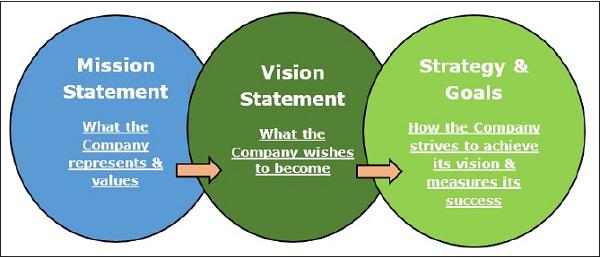
Values
Every organization has a set of values. Sometimes they are written down and sometimes not. Written values help an organization define its culture and belief. Organizations that believe and pledge to a common set of values are united while dealing with issues internal or external.
An organization’s values can be defined as the moral guide for its business practices.
Core Values
Every company, big or small, has its core values which forms the basis over which the members of a company make decisions, plan strategies, and interact with each other and their stakeholders. Core values reflect the core behaviors or guiding principles that guide the actions of employees as they execute plans to achieve the mission and vision.
Core values reflect what is important to the organization and its members.
Core values are intrinsic - they come from leaders inside of the company.
Core values are not necessarily dependent on the type of company or industry and may vary widely, even among organizations that do similar types of work.
For many companies, adherence to their core values is a goal, not a reality.
It is often said that companies that abandon their core values may not perform as well as those that adhere to them.
Stakeholders
Any individual or groups/group of individuals who believe and have an interest in an organization’s ability to deliver intended results and affect or are affected by its outcomes are called stakeholders. Stakeholders play an integral part in the development and ultimate success of an organization.
An organization is usually accountable to a broad range of stakeholders, including shareholders, who are an integral part of an organization’s strategy execution. This is the main reason managers must consider stakeholders’ interests, needs, and preferences. A stakeholder is anybody who can affect or is affected by an organization, strategy or project. They can be internal or external and they can be at senior or junior levels.
Types of Stakeholders
Stakeholders are people who have the power to impact an organization or a project in some way.
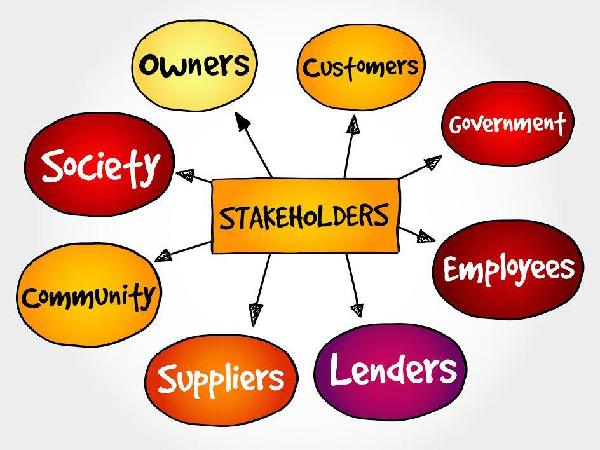
Stakeholders can be of two types −
- Primary or Internal stakeholders
- External stakeholders
Primary or Internal Stakeholders
These are groups or individuals who are directly engaged in economic transactions within the business, such as employees, owners, investors, suppliers, creditors, etc.
For example, employees contribute their skill/expertise and wish to earn high wages and retain their jobs. Owners exercise control over the business with a view to maximizing the profit of the business.
Secondary or External Stakeholders
These are groups or individuals who need not necessarily be engaged in transaction with the business but are affected in some way from the decisions of the business, such as customers, suppliers, creditors, community, trade unions, and the government.
For example, the trade unions are interested in the organization’s well-being so that the workers are well paid and treated fairly. Customers want the business to produce quality products at reasonable prices.
Identification of Key Stakeholders
It is very important for any business to identify its key stakeholders and scope their involvement as they play a vital role right from strategizing to implementation of outcomes throughout the lifetime of a business.
Different stakeholders have different interests in the organization and the management has to consider all their interests and create a synergy among them to achieve its objectives.
Identifying all of a firm’s stakeholders can be a daunting task. It is important to have the optimum number of stakeholders, neither too many nor too few. Having too many stakeholders will dilute the effectiveness of the company objectives by overwhelming decision makers with too much information and authority. Following are some effective techniques to identify key stakeholders −
Brainstorming − This is done by including all the people already involved and aware of the company and its objectives, and encouraging them to come out with their ideas. Stakeholders can be brainstormed based on categories such as internal or external.
Determining power and influence over decisions − Identify the individuals or groups that exercise power and influence over the decisions the firm makes. Once it is determined who has a stake in the outcome of the firm’s decisions as well as who has power over these decisions, there can be a basis on which to allocate prominence in the strategy-formulation and strategy-implementation processes.
Determining influences on mission, vision and strategy formulation − Analyze the importance and roles of the individuals or groups who should be consulted as strategy is developed or who will play some part in its eventual implementation.
Checklist − Make a checklist or questions to help identify the more influential or important stakeholders.
Who will be affected positively or negatively, and to what extent?
Who influences the opinions about the company?
Who has been involved in any similar projects in the past?
Which groups will benefit from successful execution of the strategy and which may be adversely affected?
Involve the already identified stakeholders − Once the stakeholders are identified, it is important to manage their interests and keep them involved and supportive. This is a daunting task to be performed tactfully by managers so that the organization’s higher objectives are not subordinated by individual interests.
Personalty and Attitude
Every organization is a mix of individuals with a variety of personalities, values, and attitudes. Personality and characteristics determine an employee’s behavior and ability to perform. Organizations hire people on the premise that they have certain knowledge, skills, abilities, personalities, and values which they bring to the workplace.
Role of Personality and Attitude in Organization
Personality contributes in part to workplace behavior because the way that people think, feel, and behave affects many aspects of the workplace. Attitude is another major factor to be considered here. People's personalities influence their behavior in groups, their attitudes, and the way they make decisions.
Today, at the hiring stage itself many organizations are attempting to screen applicants who are more likely to fit with their company culture. Organizations want to hire individuals with positive traits and attitudes to create a healthy environment.
Importance of Personality
Personality is a set of distinctive individual characteristics, including motives, emotions, values, interests, attitudes, and competencies. It is a stable set of characteristics representing internal properties of an individual, which are reflected in behavioral tendencies across a variety of situations.
It determines an employee’s fitment in terms of personality, attitude and general work style. In managing the day-to-day challenges, it is the personality of the people involved that affects the decisions taken in an organization. For example, a manager who cannot motivate his staff positively risks the integrity of the team which directly impacts the quality of service resulting in low productivity.
A manager’s personality greatly impacts motivation, leadership, performance, and conflict. The more understanding a manager has on how personality in organizational behavior works, the better equipped he will be to bring out the best in people and situation.
Personality Traits
Organizations have greatly evolved over the years in the way organizations operate and react to situations. Today they are leaner with fewer levels and more transparency. Managers are more participative involving subordinates at all levels. The shift towards more knowledge-oriented and customer-focused jobs have rendered more autonomy even at fairly low levels within organizations.
The constant volatility of the environment affecting organizations have made them open to changes and newness. All of these factors have contributed to personality being seen as more important now than it was in the past.
Behavior patterns have been a constantly evolving field of study where psychologists attempt to identify and measure individual personality characteristics, often called personality traits which are assumed to be some enduring characteristics that are relatively constant like dependable, trustworthy, friendly, cheerful, etc.
Modern personality theorists, Costa & McCrae, have researched and published their study of a ‘5 trait’ model which is now widely accepted among psychologists. These 5 aspects of personality are referred to as the 5-factors or sometimes just ‘the Big 5’.
The Big 5 Personality Traits
There are a number of traits on which persons can be ranked or measured. However, five core personality traits called the five factor model have been found to be of value for use in organizational situations.
Each of these 5 personality traits describes, relative to other people, the frequency or intensity of a person's feelings, thoughts, or behaviors. Every individual possesses all 5 of these traits, but in varying degree.
For example, we can describe two managers as ‘tolerant’. But there could be significant variation in the degree to which they exercise their tolerance levels.
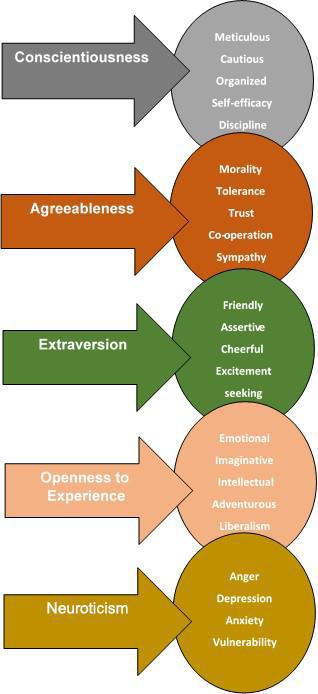
The model categorizes people as possessing the following traits in varying degrees of high scope and low scope.
Conscientiousness
High Score − Productive and disciplined, rigid and single tasking
.
Low Score − Less structured, less productive, more flexible, inventive, and capable of multitasking.
Agreeableness
High Score − Co-operative, can be submissive, and empathetic to others.
Low Score − Demanding, challenging and competitive, sometimes even argumentative.
Extraversion
High Score − Energetic, Cooperative, talkative, enthusiastic and seek excitement.
Low Score − Loners, not sympathetic, difficult to understand, even a bit eccentric.
Openness to Experience
High Score − Beginners, curious and sometimes unrealistic.
Low Score − Grounded, practical and sometimes resist change.
Neuroticism
High Score − Calm, relaxed and rational. Sometimes can be perceived as being lazy and incapable of taking things seriously.
Low Score − Alert, anxious, sometimes unnecessarily worried.
The 5 personality traits exist on a continuum rather than as attributes that a person does or does not have. Each of these 5 traits is made up individual aspects, which can be measured independently.
The personality traits cannot be studied in isolation. Both positive and negative associations that these traits imply should be considered. For example, conscientiousness is necessary for achieving goals through dedication and focus. Conscientious people reach their goals faster. Conversely, conscientiousness is not very helpful in situations that require multi-tasking.
Other Personality Traits – Self Variables
In addition to the Big Five, researchers have proposed various other dimensions or traits of personality. They are called self-variables. People's understanding about themselves is called self-concept in personality theory and are important self-variables that have application in organizational behavior. These include self-monitoring, self-esteem, self-efficacy, etc.
Self-esteem is the self-perceived competence and self-image. It is related to higher levels of job satisfaction and performance levels on the job. People with low self-esteem experience high levels of self-doubt and question their self-worth.
Self-monitoring is the extent to which a person is capable of monitoring his or her actions and appearance in social situations.
Self-efficacy is the belief in one’s abilities that one can perform a specific task successfully. A person may have high self-efficacy in being successful academically, but low self-efficacy in relation to his/her ability to fix the car.
Personality thus impacts a person's performance in various dimensions in the workplace. Not every personality is suited for every job position, so organizations need to carefully consider personality traits and assign duties/roles accordingly. This can lead to increased productivity and job satisfaction.
Work Attitude and Behaviour
Each one of us has our own belief or attitude towards the food we eat, the place we live, the clothes we wear, etc. Similarly, work attitude refers to how an individual feels about his work and shows his commitment towards it.
Attitudes are a way of thinking, and they shape how we relate to the world, both at work and outside of work. An attitude denotes our opinions, beliefs, and feelings about various aspects of our environment.
Positive Work Attitude
Positive work attitude is extremely important because it fosters productive thinking and leads to productive working. A positive person is more approachable and easily builds constructive relationships, which are essential in building cohesive teams.
The two job attitudes that have the greatest potential to influence how an individual behaves at work are − Job Satisfaction and Organizational Commitment.
People consider and evaluate their work environment based on several factors like the nature of the job, the rapport and relationship they share with their superiors and peers, how they are treated in the organization and the level of stress the job involves. Work attitudes that have the greatest potential to influence how an employee behaves are job satisfaction and organizational commitment.
Job Satisfaction
The feelings people have toward their job. It is probably the most important job attitude and denotes how satisfied an employee is at his work. A person with high job satisfaction appears to hold generally positive attitude, and one who is dissatisfied holds negative attitude towards their job.
Organizational Commitment
Organizational commitment is the emotional or psychological attachment people have toward the company they work for. A highly committed employee identifies completely with the organizations’ objectives and is willing to put in whatever effort it takes to meet them. Such an employee will be willing to remain with the organization and grow with it.
Factors Contributing to Job Satisfaction and Organizational Commitment
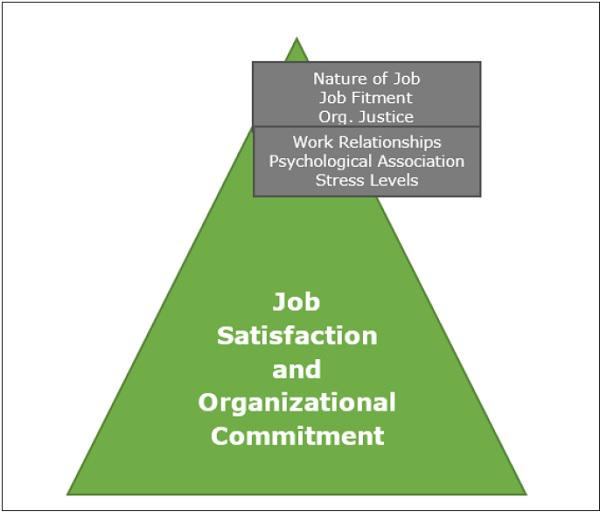
Employees tend to associate satisfaction and commitment in jobs with certain characteristics.
Nature of Job − Employees are satisfied and committed when they feel that their job provides the ability to use their inherent skills, having autonomy at work, performing a seemingly significant task, having healthy feedback mechanism, etc. Employees also tend to be more satisfied when their jobs help them build new skills and improve themselves.
Job Fitment − It is the degree to which an employee’s personal beliefs, values and goals are in synergy with those of the organization. An employee who sees a healthy synergy will remain satisfied and committed.
Organizational Justice − Every individual likes to be treated fairly in all situations. This also applies to the workplace and plays a big role in creating and sustaining satisfaction and commitment levels. How fair the company policies are, how fairly the management and superiors treat the employees and how fair is the compensation an employee receives in return for his contribution, are some factors.
Work Relationships − Another major influencer of an employee’s satisfaction and commitment is the relationship with juniors, peers and managers. Relationship refers to the way they are treated, whether they are socially accepted in the work group, how considerate is the manager, how fair he is towards the employees, etc.
Psychological Association − An employee who is emotionally attached with the organization will be satisfied and willing to commit himself to achieving the organizational objectives. It is the unspoken informal bond that silently plays a major positive influence.
Decision Making Nature Significance
Decision making is an integral part of every aspect of life. This also applies to organizations. It is one of the key factors that pave the way for its success or failure. Every manager is required to execute decisions at various levels of the management cycle beginning from planning to control. It is the effectiveness and quality of those decisions that determine how successful a manager is.
Without decision making, different managerial functions such as planning, organizing, directing, controlling, and staffing cannot be conducted. Decision making is a cumulative and consultative process, and should support organizational growth.
The main function of every management is making the right decisions and seeing them through to their logical end through execution. Every management decision also affects employee morale and performance, ultimately influencing the overall business performance. The importance of decision making in management is immense, as the business policy and strategies adopted ultimately affects the company's output and performance.
Decision making is the coherent and rational process of identifying a set of feasible alternatives and choosing a course of action from them.
Types of Decisions
Decision making and problem solving is a continuous process of analyzing and considering various alternatives in various situations, choosing the most appropriate course of action and following them up with the necessary actions.
There are two basic types of decisions −
- Programmed Decisions
- Non-programmed Decisions
Programmed Decisions
Programmed decisions are those that are made using standard operating procedures or other well-defined methods. They are situations that are routine and occur frequently.
Organizations come up with specific ways to handle them. Programmed decisions are effective for day-to-day issues such as requests for leave or permissions by employees. Once the decision is taken, the program specifies processes or procedures to be followed when similar situation arises. Creating such programed routines lead to the formulation of rules, procedures and policies, which becomes a standard in the organization.
Non-programmed Decisions
Non-programmed decisions are unique and one-shot decisions. They are not as structured as programmed decisions and are usually tackled through judgment and creativity.
They are innovative in essence, as newly created or unexpected problems are settled through unconventional and novel solutions.
Factors Affecting Decision Making
Decisions are typically made under one of three conditions −
- Certainty
- Risk and
- Uncertainty
These conditions are based on the amount of knowledge the decision maker has regarding the final outcome of the decision. The manager's decision depends on a number of factors, like the manager's knowledge, experience, understanding and intuition.
Certainty
Decisions are made under conditions of certainty when the manager has enough information to know the outcome of the decision before it is made.
The manager knows the available alternatives as well as the conditions and consequences of those actions.
There is little ambiguity and hence relatively low possibility of making a bad decision.
Risk
Most managerial decisions are made under conditions of risk.
Decisions are taken in risk when the manager has some information leading to the decision but does not know everything and is unsure or unaware of the consequences.
Under conditions of risk, the manager may find it helpful to use probability estimates. This is where the manager’s experience and/or intelligence is of great help.
Uncertainty
Decisions are made under uncertainty when the probabilities of the results are unknown.
There is no awareness of all the alternatives and also the outcomes, even for the known alternatives.
Under such conditions managers need to make certain assumptions about the situation in order to provide a reasonable framework for decision making. Intuition, judgment, and experience always play a major role in the decision making process under conditions of uncertainty.
The decision-making process involves the following steps −
- Define the problem
- Identify limiting factors
- Develop potential alternatives
- Analyze and select the best alternatives
- Implement the decision

Define the Problem
The first step in the process of decision making is the recognition or identification of the problem, and recognizing that a decision needs to be taken.
It is important to accurately define the problem. Managers can do this by identifying the problem separately from its symptoms. Studying the symptoms helps getting closer to the root cause of the problem.
Identify Limiting Factors
In order to choose the best alternative and make a decision every manager needs to have the ideal resources − information, time, personnel, equipment, and supplies. But this is an ideal situation and may not always be possible.
A limiting factor is something that stands in the way of accomplishing a desired objective.
Develop Potential Alternatives
Recognizing the limiting factor in a given situation makes it possible to narrow down the search for alternatives and make the best decision possible with the information, resources, and time available.
Some methods for developing alternatives are −
Brainstorming, where a group works together to generate ideas and alternative solutions.
Nominal group technique is a method that involves the use of a highly structured meeting, complete with an agenda, and restricts discussion or interpersonal communication during the decision-making process.
Delphi technique where the participants do not meet, but a group leader uses written questionnaires to conduct the decision making.
Analyze the Alternatives
This is an important stage in the decision-making process and perhaps the toughest. Managers must identify the merits and demerits of each alternative and weigh them in light of various situations before making a final decision.
Evaluating the alternatives can be done in numerous ways. Here are a few possibilities −
- Qualitative and quantitative measurements
- Perform a cost‐effectiveness analysis for each alternative
- Marginal analysis
Selecting Alternatives
Once the alternatives are analyzed and evaluated, the manager has to choose the best one. The manager needs to choose the alternative that gives the most advantage while meeting all the required criteria. Sometimes the choice is simple with obvious benefits, at times the optimal solution is a combination of several alternatives. At times when the best alternative may not be obvious, the manager uses probability estimates, research and analysis aided by his experience and judgment.
Evaluating Decision Effectiveness
The job of the managers does not end with making decisions. They are also responsible to get favorable results from the decision taken and implemented.
The effectiveness of a decision can be understood through a systematic and scientific evaluation system that provides feedback on how well the decision is being implemented, what the results have been, and what amendments and adjustments have been made to get the intended results.
Decision Making - Styles
Decision making style of managers depend greatly on their personality and approach towards problem solving. Every leader or manager has his own individualistic style augmented by his experience, background, and abilities.
| Directive or Autocratic Decision Making |
Managers who follow this style assess few alternatives and consider limited information while taking any decision.
They do not find it important to consult with others or seek information in any form and use their logic and idea while taking decisions.
|
| Analytical Decision Making |
Managers using analytic decision making style would like to have more information and consider more alternatives before coming to a conclusion.
They seek relevant information from their sources and consider factual and detailed information before taking any decision. Such managers are careful decision makers as they have the ability to adapt or cope with unique situations.
|
| Behavioral Decision Making |
Leaders who follow this model believe in participative management and consider the achievement of subordinates and always take suggestions from them.
They try to get inputs from subordinates through meetings and discussions. They try to avoid/resolve conflicts as acceptance by others is important to them.
|
| Conceptual Decision Making |
Managers using conceptual decision making style are intuitive in their thinking and have high tolerance for ambiguity.
They look at many alternatives and focus on long run outcomes.
|
Decision Making - Tools
Decision making is a very important and complex process. In order to aid decision makers make the right choice, quantitative techniques are used that improve the overall quality of decision making.
Following are some of the commonly used techniques −
Decision Trees
Decision Trees are tools that help choose between several courses of action or alternatives. They are −
Represented as tree-shaped diagram used to determine a course of action or show a statistical probability.
Each branch of the decision tree represents a possible decision or occurrence.
The tree structure shows how one choice leads to the next, and the use of branches indicates that each option is mutually exclusive.
A decision tree can be used by a manager to graphically represent which actions could be taken and how these actions relate to future events.
Delphi Technique
Delphi Technique is a method used to estimate the likelihood and outcome of future events. It is unique because −
It is a group process using written responses to a series of questionnaires instead of physically bringing individuals together to make a decision.
Individuals are required to respond to a set of multiple questionnaires, with each subsequent questionnaire built from the information gathered in the previous one.
The process ends when the group reaches a consensus.
The responses can be kept anonymous if required.
Payback Analysis
Payback analysis is a technique generally used in financial management.
It refers to the period of time required to recoup the funds expended in an investment, or to reach the break-even point.
It is generally used to evaluate capital-purchasing alternatives.
Alternatives are ranked according to the time each takes to pay back its initial cost.
The strategy is to choose the alternative that has the quickest payback of the initial cost.
Simulations
Simulation is a technique that attempts to replace and amplify real experiences with guided techniques.
It is a widely used technique in operations research.
It models the behavior of individual elements within a given system.
Methods generally used in simulation are random sampling to generate realistic variability.
The overall behavior of the system emerges from the interactions between the elements.
Widely used application areas of the simulation technique are - logistics and supply chain, service and operations management, business process improvement, health and social care information system, environment, etc.
Planning Introduction
Every organization as part of its life cycle constantly engages in the four essential functions of management – planning, leading, organizing and controlling. The foremost of this is planning. It is the part of management concerned with creating procedures, rules and guidelines for achieving a stated objective. All other managerial functions must be planned if they are to be effective.
Managers at all levels engage in planning as objectives and goals have to be set up for the day-to-day activities as well as the broader long-term initiatives.
What is Planning?
Planning is the most basic of all managerial functions which involves establishing goals, setting out objectives and defining the methods by which these goals and objectives are to be attained. It is, therefore, a rational approach to achieving pre-selected objectives.
Planning involves selecting missions and objectives and the actions to achieve them. An important aspect of planning is decision making - that is, choosing the right alternatives for the future course of action.
Organizations have to typically plan for long-range and short-range future direction. By forecasting and predicting the market and socio-political-economic trends, managers can plan to determine where they desire the company to be in future.
Planning involves determining various types and volumes of physical and other resources to be acquired from outside, allocating these resources in an efficient manner among competing claims and to make arrangement for systematic conversion of these resources into useful outputs.
Since plans are made to attain goals or objectives, every plan should lead to the achievement of the organization’s purpose and objectives. An organized enterprise exists to accomplish group objectives through willing and purposeful co-operation.
Planning bridges the gap between where the organization stands currently and wishes to be in future. In the absence of planning, events are left to chance.
Importance of Planning
The importance of planning as the major constituent in the management process is universally accepted. Planning not only brings stability and certainty to business, it also brings in a unified sense of direction and purpose for the achievement of certain well-defined objectives.

The basic reasons supporting systematic planning by managers are −
Sense of Direction − Planning provides a unity of purpose. It brings together all resources towards achieving common goals. Without plans and goals, organizations will respond to everyday events in an ad-hoc manner without considering long-term possibilities.
Resource Paucity − Resource crunch is a major challenge for organizations today. Managements are confronted with the task of optimizing outputs with limited human, material, and financial resources through intelligent planning; otherwise, wasteful inefficiencies would lead to higher prices and severe shortages.
Uncertainty − Uncertainty is a major challenge even to the most intelligent planner. Organizations continually face micro and macro-economic uncertainty in the course of accomplishing their tasks. Planning helps managers anticipate such changes and meet these challenges.
Besides the above, there are several practical reasons for formulating plans.
To focus organizational activity on a set of consciously created objectives.
To provide a systematic guide for future activities.
To increase organizational outcome through efficient operation.
To encourage systematic thinking. Planning facilitates effective delegation of authority, removes communication gaps, and thereby raises overall efficiency.
Management Principles - Types Of Plans
Plans commit the various resources in an organization to specific outcomes for the fulfillment of future goals. Many different types of plans are adopted by management to monitor and control organizational activities. Three such most commonly used plans are hierarchical, frequency-of-use (repetitiveness) and contingency plans.

Strategic Plans
Strategic plans define the framework of the organization’s vision and how the organization intends to make its vision a reality.
It is the determination of the long-term objectives of an enterprise, the action plan to be adopted and the resources to be mobilized to achieve these goals.
Since it is planning the direction of the company’s progress, it is done by the top management of an organization.
It essentially focuses on planning for the coming years to take the organization from where it stands today to where it intends to be.
The strategic plan must be forward looking, effective and flexible, with a focus on accommodating future growth.
These plans provide the framework and direction for lower level planning.
Tactical Plans
Tactical plans describe the tactics that the managers plan to adopt to achieve the objectives set in the strategic plan.
Tactical plans span a short time frame (usually less than 3 years) and are usually developed by middle level managers.
It details specific means or action plans to implement the strategic plan by units within each division.
Tactical plans entail detailing resource and work allocation among the subunits within each division.
Operational Plans
Operational plans are short-term (less than a year) plans developed to create specific action steps that support the strategic and tactical plans.
They are usually developed by the manager to fulfill his or her job responsibilities.
They are developed by supervisors, team leaders, and facilitators to support tactical plans.
They govern the day-to-day operations of an organization.
Operational plans can be −
Standing plans − Drawn to cover issues that managers face repeatedly, e.g. policies, procedures, rules.
Ongoing plans − Prepared for single or exceptional situations or problems and are normally discarded or replaced after one use, e.g. programs, projects, and budgets.
Planning Environment
Planning is the fundamental process in management which moves gradually and a step-by-step approach is usually adopted. It involves the determination of objectives and outlines the future actions needed to achieve these objectives. The above diagram represents the planning process.
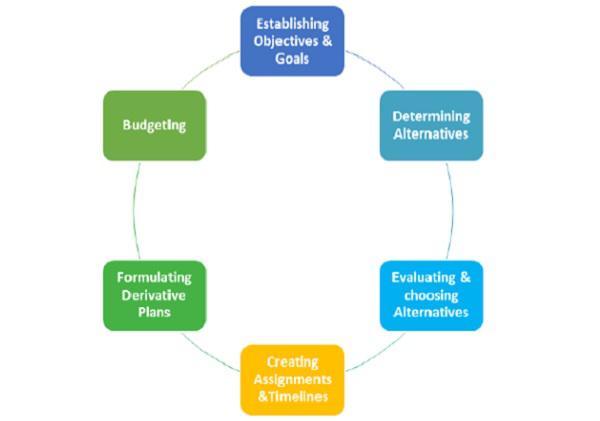
Establishing Objectives and Goals
The first step of the management planning process is to identify goals specific to the organization and also for each department unit. A comprehensive planning effort to be successful requires that managers in each department be involved in the planning process. Thus objectives and goals which will direct the future course of the organization must be clear, concise and specific.
At this stage, the planning process should include a detailed overview of each goal, including the reason for its selection and the anticipated outcomes of goal-related projects. The objectives thus established govern the framework for every major department, which in turn, control the objectives of subordinate departments and so on down the line.
Determining Alternatives
The next step is to search for and find out alternatives that will guide the fulfillment of the objectives established. At this stage, managers need to plan on how to move from their current position towards their decided future position.
Managers may find many alternatives, however, dropping the less desirable ones and narrowing on the few desired alternatives is what will help in identifying the best fit solution. The manager can take the help of quantitative techniques, research, experimentation, and experience to determine various alternatives.
Evaluating and Choosing Alternatives
Once alternative courses of action have been identified, each alternative has to be analyzed and evaluated in the light of its strength and weakness and its fitment in achieving the organizational goals. While evaluating alternatives, managers should consider facts like the costs involved, how resource intensive it is, the time frame for completion, the gestation period, return on investment, etc.
Major challenges of effective evaluation can be uncertainty about the future and risk. Various intangible factors which are not within the control of the management like market changes, socio-economic-political factors, etc. also have a bearing. At this stage, managers can use operations research, and mathematical as well as computing techniques to predict and analyze alternatives.
Creating Assignments and Timelines
As the plans are frozen and prioritized, timelines for completing associated tasks need to be finalized. At this stage, resource allocation and the line of authority and responsibility also needs to be established. The manager should consider the abilities of staff members and allocate the best fit resource for the job.
Also the timelines for completion should be realistic and fair. This step in the planning process is important as it brings coordination in the activities of different departments. The timings and sequence of operations must be communicated to the concerned departments, managers and staff for implementation of the plan.
Formulating Derivative Plans
Derivative plans are sub-sections of the operating plan. The division of overall plan into derivative plans is necessary for effective execution. Derivative plans are essentially required to support the basic or general plan and explain the many details involved in reaching a broad major plan.
Budgeting
Once the plans are finalized and set, the final step is to convert them into quantifiable parameters through budgeting. Budgets are most commonly expressed in terms of money, but are also expressed as hours worked, as units sold, or in any other measurable unit.
An enterprise usually has overall budgets representing the sum total of income and expenses, with consequent profit or surplus. Each department of the enterprise or organization can have its own budget, commonly of expenses and capital expenditures, which make up the overall budget. A well planned budgeting exercise can become a standard for measuring the progress and effectiveness of the planning process.
Importance Of Organizing
Organizations are systems created to achieve common goals through people-to-people and people-to-work relationships. They are essentially social entities that are goal-directed, deliberately structured for coordinated activity systems, and is linked to the external environment. Organizations are made up of people and their relationships with one another. Managers deliberately structure and coordinate organizational resources to achieve the organization’s purpose.
Each organization has its own external and internal environments that define the nature of the relationships according to its specific needs. Organizing is the function that managers undertake to design, structure, and arrange the components of an organization’s internal environment to facilitate attainment of organizational goals.
Organizing creates the framework needed to reach a company's objectives and goals.
Organizing is the process of defining and grouping activities, and establishing authority relationships among them to attain organizational objectives.
Importance of Organizing
A comprehensive approach to organizing helps the management in many ways. Organizing aligns the various resources towards a common mission.
Efficient Administration
It brings together various departments by grouping similar and related jobs under a single specialization. This establishes coordination between different departments, which leads to unification of effort and harmony in work.
It governs the working of the various departments by defining activities and their authority relationships in the organizational structure. It creates the mechanism for management to direct and control the various activities in the enterprise.
Resource Optimization
Organizing ensures effective role-job-fit for every employee in the organization. It helps in avoiding confusion and delays, as well as duplication of work and overlapping of effort.
Benefits Specialization
It is the process of organizing groups and sub-divide the various activities and jobs based on the concept of division of labor. This helps in the completion of maximum work in minimum time ensuring the benefit of specialization.
Promotes Effective Communication
Organizing is an important means of creating coordination and communication among the various departments of the organization. Different jobs and positions are interrelated by structural relationship. It specifies the channel and mode of communication among different members.
Creates Transparency
The jobs and activities performed by the employees are clearly defined on the written document called job description which details out what exactly has to be done in every job. Organizing fixes the authority-responsibility among employees. This brings in clarity and transparency in the organization.
Expansion and Growth
When resources are optimally utilized and there exists a proper division of work among departments and employees, management can multiply its strength and undertake more activities. Organizations can easily meet the challenges and can expand their activities in a planned manner.
Management - Principles of Organizing
The following illustration shows the five principles of Organizing −
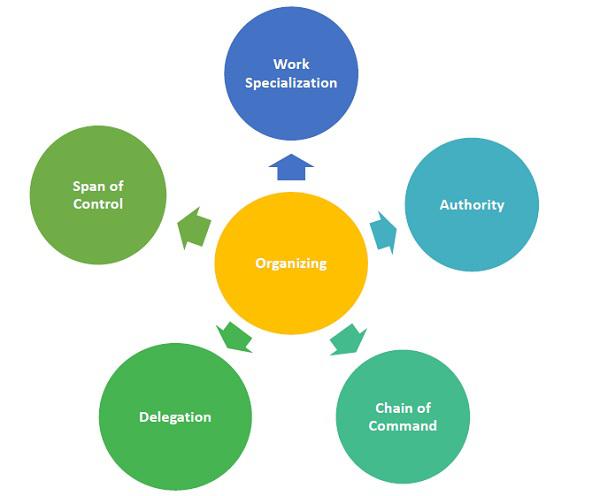
Work Specialization
Also called division of labor, work specialization is the degree to which organizational tasks are divided into separate jobs. Each employee is trained to perform specific tasks related to their specialized function.
Specialization is extensive, for example running a particular machine in a factory assembly line. The groups are structured based on similar skills. Activities or jobs tend to be small, but workers can perform them efficiently as they are specialized in it.
In spite of the obvious benefits of specialization, many organizations are moving away from this principle as too much specialization isolates employees and narrows down their skills to perform routine tasks.
Also it makes the organization people dependent. Hence organizations are creating and expanding job processes to reduce dependency on particular skills in employees and are facilitating job rotation among them.
Authority
Authority is the legitimate power assigned to a manager to make decisions, issue orders, and allocate resources on behalf of the organization to achieve organizational objectives.
Authority is within the framework of the organization structure and is an essential part of the manager’s job role. Authority follows a top-down hierarchy. Roles or positions at the top of the hierarchy are vested with more formal authority than are positions at the bottom.
The extent and level of authority is defined by the job role of the manager. Subordinates comply with the manager’s authority as it is a formal and legitimate right to issue orders.
Chain of Command
The chain of command is an important concept to build a robust organization structure. It is the unbroken line of authority that ultimately links each individual with the top organizational position through a managerial position at each successive layer in between.
It is an effective business tool to maintain order and assign accountability even in the most casual working environments. A chain of command is established so that everyone knows whom they should report to and what responsibilities are expected at their level. A chain of command enforces responsibility and accountability. It is based on the two principles of Unity of command and Scalar Principle.
Unity of command states that an employee should have one and only one manager or supervisor or reporting authority to whom he is directly accountable to. This is done to ensure that the employee does not receive conflicting demands or priorities from several supervisors at once, placing him in a confused situation.
However, there are exceptions to the chain of command under special circumstances for specific tasks if required. But for the most part organizations to a large extent should adhere to this principle for effective outcomes.
Scalar principle states that there should exist a clear line of authority from the position of ultimate authority at the top to every individual in the organization, linking all the managers at all the levels. It involves a concept called a gang plank
using which a subordinate may contact a superior or his superior in case of an emergency, defying the hierarchy of control. However, the immediate superiors must be informed about the matter.
Delegation
Another important concept closely related to authority is delegation. It is the practice of turning over work-related tasks and/or authority to employees or subordinates. Without delegation, managers do all the work themselves and underutilize their workers. The ability to delegate is crucial to managerial success.
Authority is said to be delegated when discretion is vested in a subordinate by a superior. Delegation is the downward transfer of authority from a manager to a subordinate. Superiors or managers cannot delegate authority they do not have, however, high they may be in the organizational hierarchy.
Delegation as a process involves establishment of expected outcomes, task assignment, delegation of authority for accomplishing these tasks, and exaction of responsibility for their accomplishment. Delegation leads to empowerment, as employees have the freedom to contribute ideas and do their jobs in the best possible ways.
Span of Control
Span of control (also referred to as Span of Management) refers to the number of employees who report to one manager. It is the number of direct reportees that a manager has and whose results he is accountable for.
Span of control is critical in understanding organizational design and the group dynamics operating within an organization. Span of control may change from one department to another within the same organization.
The span may be wide or narrow. A wide span of control exists when a manager has a large number of employees reporting to him. Such a structure provides more autonomy. A narrow span of control exists when the number of direct reportees that a manager has is small. Narrow spans allow managers to have more time with direct reports, and they tend to spark professional growth and advancement.
Organizational Structure
An organization is a social unit of individuals that is designed and managed to achieve collective goals. As such organizations are open systems that are greatly affected by the environment they operate in. Every organization has its own typical management structure that defines and governs the relationships between the various employees, the tasks that they perform, and the roles, responsibilities and authority provided to carry out different tasks.
An organization that is well structured achieves effective coordination, as the structure delineates formal communication channels, and describes how separate actions of individuals are linked together.
Organizational structure defines the manner in which the roles, power, authority, and responsibilities are assigned and governed, and depicts how information flows between the different levels of hierarchy in an organization.
The structure an organization designs depends greatly on its objectives and the strategy it adopts in achieving those objectives.
An organizational chart is the visual representation of this vertical structure. It is therefore very important for an organization to take utmost care while creating the organizational structure. The structure should clearly determine the reporting relationships and the flow of authority as this will support good communication – resulting in efficient and effective work process flow.
Common Organization Structures
Managements need to seriously consider how they wish to structure the organization. Some of the critical factors that need to be considered are −
- The size of the organization
- Nature of the business
- The objectives and the business strategy to achieve them
- The organization environment
Functional Organization Structure
The functional structure is the most common model found in most organizations. Organizations with such a structure are divided into smaller groups based on specialized functional areas, such as operations, finance, marketing, Human Resources, IT, etc.

The organization’s top management team consists of several functional heads (such as the VP Operations, VP Sales/Marketing). Communication generally occurs within each functional department and is communicated across departments through the department heads.
This structure provides greater operational efficiency as employees are functionally grouped based on expertise and shared functions performed. It allows increased specialization as each group of specialists can operate independently.
In spite of the above benefits there are some issues that arise with this structure. When different functional areas turn into silos they focus only on their area of responsibility and do not support other functional departments. Also expertise is limited to a single functional area allowing limited scope for learning and growth.
Product Organizational Structure
This is another commonly used structure, where organizations are organized by a specific product type. Each product category is considered a separate unit and falls within the reporting structure of an executive who oversees everything related to that particular product line. For example, in a retail business the structure would be grouped according to product lines.
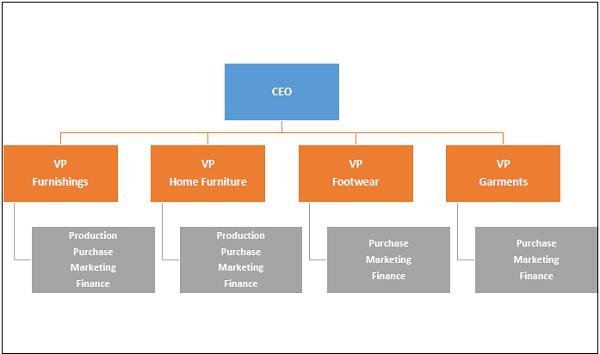
Organization structured by product category facilitates autonomy by creating completely separate processes from other product lines within the organization. It promotes depth of understanding within a particular product area and also promotes innovation. It enables clear focus with accountability for program results.
As with every model, this model also has a few downsides like requirement of strong skills specializing in the particular product. It could lead to functional duplication and potential loss of control; each product group becomes a heterogeneous unit in itself.
Geographic Organizational Structure
Organizations that cover a span of geographic regions structure the company according to the geographic regions they operate in. This is typically found in organizations that go beyond a city or state limit and may have customers all across the country or across the world.
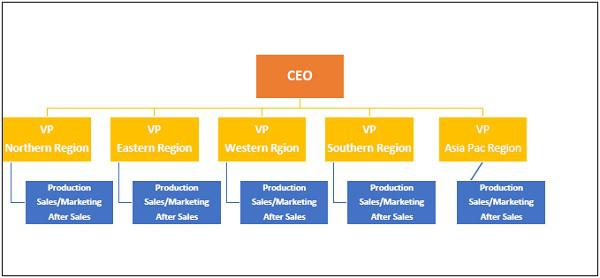
It brings together employees from different functional specialties and allows geographical division. The organization responds more quickly and efficiently to market needs, and focuses efforts solely on the objectives of each business unit, increasing results.
Though this structure increases efficiency within each business unit, it reduces the overall efficiency of the organization, since geographical divisions duplicate both activities and infrastructure. Another main challenge with this model is that it tends to be resource intensive as it is spread across and also leads to duplication of processes and efforts.
Matrix Organizational Structure
A matrix structure is organized to manage multiple dimensions. It provides for reporting levels both horizontally as well as vertically and uses cross-functional teams to contribute to functional expertise. As such employees may belong to a particular functional group but may contribute to a team that supports another program.
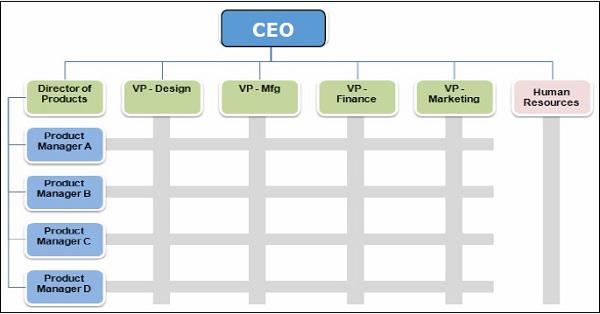
This type of structure brings together employees and managers across departments to work toward accomplishing common organizational objectives. It leads to efficient information exchange and flow as departments work closely together and communicate with each other frequently to solve issues.
This structure promotes motivation among employees and encourages a democratic management style where inputs from team members are sought before managers make decisions.
However, the matrix structure often increases the internal complexity in organizations. As reporting is not limited to a single supervisor, employees tend to get confused as to who their direct supervisor is and whose direction to follow. Such dual authority and communication leads to communication gaps, and division among employees and managers.
Organizational Process
Organizing, like planning, must be a carefully worked out and applied process. This process involves determining what work is needed to accomplish the goal, assigning those tasks to individuals, and arranging those individuals in a decision‐making framework (organizational structure).
The Organization Process Chart
Following is a representation of organization process chart.
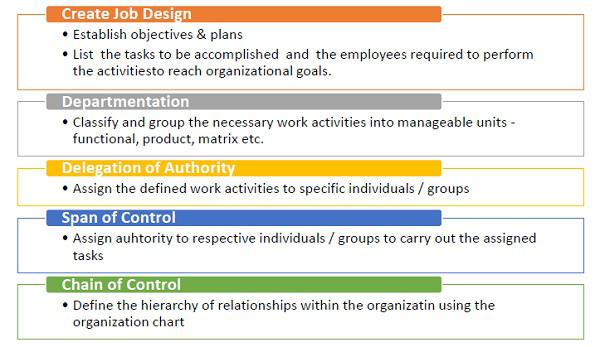
A well-defined organizing process leads to improved communication, transparency and efficiency in the organization.
Organizational Change
One of the greatest challenges faced by organizations today is the volatility of the global markets. Globalization has greatly affected the market and so have opportunities for more growth and revenue. However, to serve such a diverse marketplace, organizations need to respond to and understand the needs and expectations of the marketplace.
Organizations are required to constantly innovate and update their processes and operational efficiencies to collaborate with the expanding markets. Organizations that refuse to change or move forward are forced to exit the market or may be wiped out by forward looking companies.
It is this movement or shift in an organization to improve the performance of the entire organization or a part of the organization that is referred to as Organizational Change.
Organizational change is a process in which a large company or an organization changes its working methods or aims, in order to develop and respond to new situations or markets.
Why Organizations Need to Change
Substantial organizational changes take place typically when organizations perceive a need to change the overall strategy and direction for success, adds or discontinues a major segment or practice, and/or wants to change the very nature by which it operates.
It also occurs when an organization evolves through its life cycles, and has to restructure itself to grow. Organizational change is often a response to changes in the environment. Some of the reasons prompting changes are −
Market Dynamics
The changing market conditions cause unexpected changes which organizations find hard to adjust to. To stay in business and continue to serve the customers, organizations have to align themselves to these variations.
Globalization
Globalization has created enormous opportunities as well as global challenges to organizations. The market has thus expanded across geographies, and organizations in order to succeed have to serve customers across these regions. While doing this, organizations are finding it more affordable and logical to produce goods and deliver services in certain countries compared to others. The availability of local resources, the environment of the countries they serve in, localization of goods and services, etc. are some reasons for this. To cater to global market, organizations have to understand the global environment and market behavior, and align the organizations to these new situations.
Organizational Development
As organizations grow and develop in size, the policies, procedures and the structure that forms the core, also needs to evolve. Organizational changes may involve changes to its mission and objectives, strategy and direction, organizational structure and hierarchy, etc. Adjusting an organization’s internal direction and environment requires considerable dedication and a careful management.
Reaction to External Environments
Organizations are greatly impacted by the environments that surround it. External pressures come from many areas, including customers, competition, changing government regulations, shareholders, financial markets, and other factors in the organization's external environment.
Performance Gaps
Organizations that have been having issues with their results are often the ones that consider changes. Performance gaps can be identified in several areas like production, sales and marketing, service, etc. Such companies need to conduct a serious study and identify factors causing gaps and change accordingly to succeed.
Mergers & Acquisitions
Mergers and acquisitions create reorganization in a number of areas. When two organizations merge, significant changes are expected.
Organizational Change Factors
Organizational change as we have read is a strategic initiative impacting almost every aspect of its operations and functions. The factors that induce changes almost always require immediate attention. The major forces that drive this change in business are −
- Internal environment
- External environment
The Internal Environment
The internal environment of an organization consists of factors within the organization over which it can exercise a fair amount of control. Some of the internal factors are −
Employees − Employees are the human capital of the organization. An organization without a motivated and dedicated workforce will not be able to perform in spite of having the best products and capital. Employees must take the initiative to change their workplace, or changes in work tasks for more efficient and effective performance.
The Organizational Structure − The organizational structure is what governs and guides the effective operations of the company. It defines and scopes the authority and hierarchy in the company. However, over time the organizational structure needs reorganization to answer to the needs of an evolving entity and becomes an internal source of organizational change.
Organization Processes − The processes in organization are collections of activities that need to be undertaken in order to produce an output, and that will have a value for consumers. There are various processes in the organization that need to be constantly updated to keep serving the market like – manufacturing, distribution, logistics, information technology, etc.
Apart from the above factors like the company's mission and objectives, organizational culture and style of leadership are factors typically associated with the internal environment of an organization and can have a considerable impact on the organization.
The External Environment
The external environment of an organization are those set of factors which the organization cannot exercise control on. Though these factors are external to the organization, they have a significant influence over its operations, growth and sustainability.
Economic Factors − The macroeconomic factors like the political and legal environment, the rate of inflation and unemployment, monetary and fiscal policies of the government, etc. are causes that have a high influence on companies and prompt for changes in the organization. Managers need to carefully track these indicators in order to make the right decisions for change.
Socio-cultural Factors − The local and regional conditions greatly influence people’s values, habits, norms, attitudes and demographic characteristics in the society. All of these factors highly influence the business operations or will do so in the future.
Global Environment − The increasing globalization of markets has made organizations sensitive to changes. Any change or crisis in the global market affects every business, and corrective measures are not often easy and immediately taken.
Technology − Technology has become an intrinsic part of business operations. It regulates processes in all aspects like manufacturing, distribution, logistics, finance, etc. Organizations have to be up-to-date with the ever-changing technological advancements in order to improve efficiencies and remain competitive.
Organizational Change Management
When organizations undertake initiative to improve performance, seize opportunities or address key issues, they often require changes − changes to processes, job roles, organizational structure, and types and use of technology.
Change Management
It is the discipline that guides, prepares, and equips organizations to successfully adopt change in order to drive organizational success.
It provides a structured approach for supporting the employees in moving forward from their current state to desirable and progressive future state.
Planning Organizational Change
Organizational change often, if not always, is an indicator of potential problems or issues with the organization. In some cases, however, voluntary changes happen in forward looking organizations that proactively recognize potential opportunities or situations.
Whatever the case, change is a shift from the current comfort state for any organization and needs to be well planned so as to not imbalance the current environment.Key steps in the process of implementing a planned organizational change is depicted in the following figure.
Organizations need to undertake thorough study to understand the existing processes and procedures, and identify the snags. Each problem area has to be evaluated and the changes required for improvement have to be assessed.
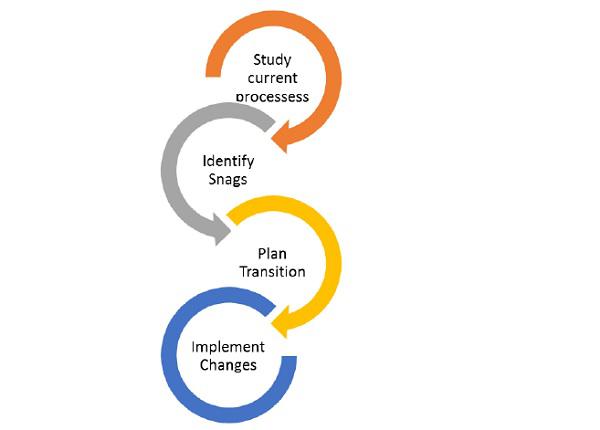
The next step is to determine the desired future state the management wishes the organization to be in. This will need to be communicated to all concerned and design the means of smooth transition.
The transition plan once finalized has to be implemented in an orderly manner. Plans have to be made and resources need to be allocated. Responsibility has to be assigned to a key person in the organization to take charge of the change process. It is essential for the top management to be involved in the whole process to direct and govern the process.
Resistance to Changes
Organizational change is sometimes unavoidable. It is a complex process that affects the organization all across. Not all employees and departments welcome changes to their existing environment and processes. It is normal human reaction to defend the status quo if security or status is threatened.
In fact, organizational change can generate skepticism and resistance in employees, making it sometimes difficult or impossible to implement organizational improvements. This makes the role of the management even more critical, to make an effort to support the employees during and even after the process of transformation.
Managing resistance to change is challenging. Some reasons why change is resisted in organizations are −
Impact of Change
Employees resist change if it is not favorable to them. They tend to be more welcoming of changes that are favorable to them and empower them. Resistance also happens when change is thrust onto people without giving them adequate warning and without helping them through the process of understanding what the change will entail and how it will impact their jobs/work.
Self-Interest Before Organizational Well-being
Some employees resist changes as it comes in the way of their personal interest and agenda. They fear that the change will delay or obstruct the fulfillment of their hidden agenda.
Personality Trait
Some are inherently more resistant to any kind of change than others. Employees having a positive and optimistic approach are more willing to accept changes than employees who have a negative approach.
Uncertainty
Change often brings feelings of uncertainty as the end result is usually unknown. The environment after transformation could change for the better or sometimes worse than it was earlier. This lack of clarity creates insecurity in employees as it leads to a sense of loss of control.
Fear of Failure
Changes in the work processes can create uncertainty over their capabilities in employees as they fear that they may not be able to adapt to the new requirements. Thus employees who are confident of their abilities and performance are more likely to welcome the proposed change, than those who have lower confidence.
Fear of Job Loss
Another important factor that causes employees to resist change is the fear that they may lose their job in the organization once the transformation is affected. This usually happens in organizations that undertake restructuring or downsizing as a major cause of the change.
Overcoming Resistance to Change
Implementing change is always difficult for organizations. But the transition can be made smooth if the management goes through it with empathy and compassion after thorough analysis, planning, and strategizing.
The top management must fully understand how change works in order to lead their organizations successfully into the future. The introduction and management of change are emerging as two of the most critical elements of leadership for the future.
Address Employee Concerns
A management that is truly concerned about its employees will address and deal with the concerns of the employees first, by giving them confidence and assuring that the change will bring positive results and then focus on the organizational benefits.
Effective Communication
A good leader is also an effective communicator. As a change agent, the leader rather than communicating with the employees what they stand to gain from the change, can have a greater impact by telling them what they stand to lose if they don’t accept the change.
Creating an Atmosphere of Trust
Exercises such as teambuilding, trust-building, and open and honest communication with the employees prior to the introduction of change will help create an atmosphere of trust. If employees are involved in the change process and their inputs sought, it will help them accept the changes implemented without fear.
Link Changes to Employee Concerns
Employees’ perception of change can be made positive and welcoming by associating the need for change to other issues that they are concerned about like issues of health, job security, and better working atmosphere.
Multinational Organizations
The evolution of multinational corporations has its root in the origin of trade in and between various cultural communities across regions. Marked by the struggle of transacting across regions, trading has always been affected by the unequal and varied distribution of resources across geographies. It is this unequal distribution that has led traders to travel long distances and undergo unusual risks for the hope of gain.
The past few decades have witnessed the way global boundaries have shrunk, and communications and technology has bridged the gap. Advancements in technology have resulted in the development of new products, processes and forms of business that have changed the dynamics of economic environment the world over.
Economies started to change to accommodate these progressive developments. Organizations in order to capitalize on the growing opportunities globally started to change and expand. This gave rise to multinational corporations.
What are MNCs?
Multinational corporations are profit seeking enterprises having international power, capital, manpower, and resource-seeking practices. We can say that an organization that performs its business in two or more countries is a multinational company. These companies operate worldwide through their own branches and subsidiaries or through agents who represent them.
All the business activities are managed and controlled by the central head office of the organization, which is usually situated in the home country of the company.
The equity capital of the subsidiaries or branches in various countries is contributed by both the host company and the parent company. However, management and control of the branches is governed and controlled by the parent company.
As these organizations coordinate production and distribution on a global scale, they become enormous in size and wield enormous power, both economically and politically.
Multinational firms arise −
Because capital as a resource is mobile and can be used across geographies.
The growing global marketplace has created enormous consumerism.
The mutual cooperation among friendly nations and development of new technology has facilitated mass production.
Inexpensive labor and skills are available in many countries.
Raw materials availability is spread across geographically.
Managers working in multinationals are required to understand and operate in multi-cultural international environment. As a result, they are required to constantly monitor the political, legal, sociocultural, economic, and technological environments across international markets.
Types of Multinational Corporations
Some of the common forms of Multinational Companies are −
Franchise Operations
Under this form, a multinational corporation endows firms in foreign countries the legal right to use its business model and brand per the terms and conditions of franchise agreement, which can be reviewed and renewed periodically. The firms who get the right or license pay royalty or license fee to multinational corporations.
Branches and Subsidiaries
In this kind of a system, the multinational company opens its own braches in different countries, which operate under the direct control and supervision of the company’s head office. Sometimes, a multinational company may establish subsidiaries in foreign countries. These subsidiaries may be fully owned by the multinational (parent company) or partly owned, where the host countries own share capital. The subsidiaries follow the guidelines of the parent company.
Joint Venture
A multinational company establishes its company in a foreign country in partnership with the local firms or companies in the host company. The ownership and control of the business is shared by multinational and foreign company, where the governing policies are that of the multinational company and the day-to-day management is left to the local company.
Global Ecosystem and its Impact
Over the past decade, the business framework and environment has undergone dramatic changes. Due to the intensification of globalization, international organizations are faced with unprecedented competition and pressures.
Organizations and respective managements have to understand that operating in the global marketplace multiplies the variables and interdependencies to be considered while making decisions. The volatile global dynamics make the decisions and plans of today outdated by next month.

The need for companies in this environment is global executives and managers who apart from analytics, skills and technical insights are able to be effective in such diverse and dynamic settings.
Thus, international managers are required to operate in the global context with changing workforce while dealing with unknown rules and regulations that are subject to unprecedented changes. The development in transnational trade has resulted in higher global standards of productivity and quality. This has changed the guidelines of leading and managing businesses internationally, making it much more complex and challenging.
Challenges Faced by International Managers
International managers are constantly faced with multiple challenges, which need to be properly understood and dealt with. Some of the challenges are −
Conduct business under local legislations in different countries, languages and currencies, for serving local markets while complying with global company standards.
Location-specific risks like unstable economies and governments, security concerns and labor availability.
Work and deal with employees from different nationalities and cultures, which requires a lot of understanding.
The ever volatile global markets, its infrastructure and the technological disparities among countries.
Overcoming Global Challenges
Organizations have to understand these challenges and work on ways to overcome them if they are to conduct successful business globally. The have to develop competencies that will enable them and their managers to effectively manage and lead international companies.
Global Competencies
Multinationals should develop global competencies based on factors like the kind of global presence the company desires, the number and type of international or global jobs it requires, etc.
Business Competencies
Business competencies involve developing business knowledge and understanding of the global business environment.
Understanding how the company fits into the global marketplace, including business strategies and products, and the organizational resources to pursue global market opportunities.
Understanding international business issues, global social, political and economic events.
Balancing global versus localization issues.
Creating learning systems for management focused on managing and leading global organizations.
Effective strategic planning and analysis of global trends to manage uncertainty.
Developing flexible policies and procedures adaptable to changing situations.
Groom globally competent managers through global leadership and development programs.
Ability to change leadership and management styles and approach based on global situations.
Personal Competencies
Personal competencies are cognitive and affective abilities that enable managers to operate in the global environment.
Learning − An important trait that enables managers learn about the work environment, the organization, the external environment and how these elements interact.
Global attitude − Sharing information, knowledge and experience across national, functional and business boundaries, and balancing business and functional priorities that emerge in the globalization process. Also includes flexibility to change leadership style and approach based on the socio-cultural behavior patterns.
Intercultural competency − Knowledge of the culture, language, cultural standards, and behavioral skills such as optimism, empathy, human warmth and the ability to manage anxiety and uncertainty.
Every international organization therefore has to carefully consider its vision and long-term strategy suitably and develop its competencies. Successful multinationals are those that have been able to break the cross-border, cultural and socio-economic barriers, aligning and localizing themselves to the countries they operate in.


